

by SUMMER 2025



by SUMMER 2025
ummer has officially arrived – and while the longer days and lighter evenings are a welcome boost, they can also bring new challenges when it comes to staying on track. In this issue of Healthy Balance, we’re here to help you enjoy the season while feeling your best – whatever the weather.
If seasonal social events and holidays tend to scupper your usual routine, don’t worry – you’re not alone. We’ll explore the most common summer sticking points and share practical tips to help you stay motivated without missing out. And for those feeling the heat in the kitchen, we’ve got you covered with no-cook meals and barbecue-friendly recipes that work just as well indoors as they do al fresco.
Looking for a fresh way to get active? Dive into our piece on outdoor swimming – we cover the benefits for body and mind, plus simple steps to help you get started safely. Or, if you’re taking a moment to reflect this summer, don’t miss our mindset feature, where we reveal the habits that help us maintain a positive relationship with food.
Elsewhere in the issue, we’ve rounded up the best low and no-alcohol options to sip this summer, whether you’re after a crisp beer or a celebratory glass of fizz. You’ll also find a Mediterranean-style three-day reset meal plan, seasonal strawberry recipes perfect for tennis season, and expert insight from Dr Campbell on sugar addiction.
Wherever summer takes you, we’re here to support your health goals – rain or shine.

Emma Senior Nutritionist at Nutracheck

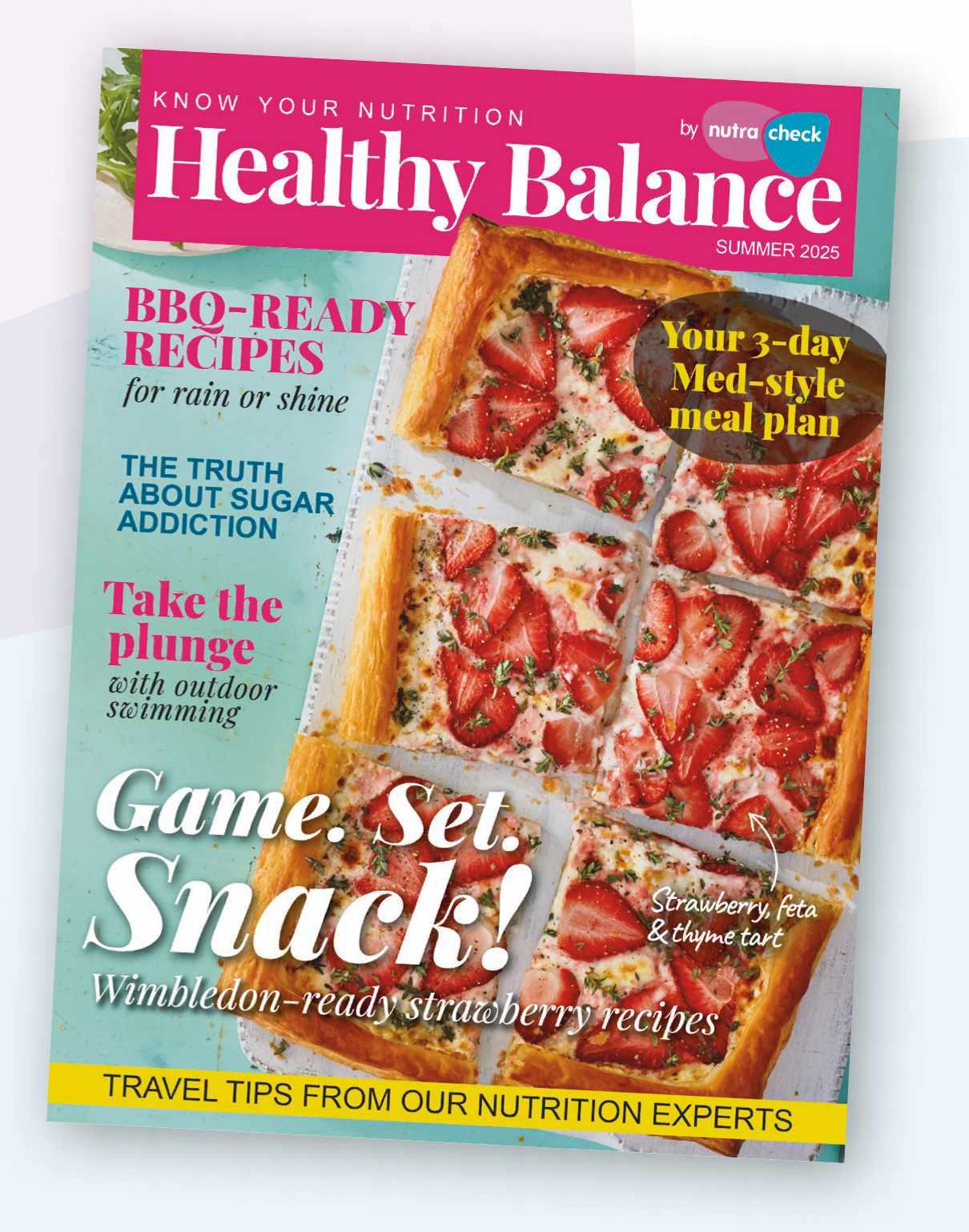
The Nutracheck Service is intended as a weight management tool to assist you in achieving your personal goal. However, NutraTech Ltd is not a medical organisation and the information contained in any articles and elsewhere in the Nutracheck app and Nutracheck website, is provided for educational purposes only. You are advised to seek medical advice before making any changes to your diet or lifestyle with an aim of weight loss or weight gain. Read the full Nutracheck T&Cs at nutracheck.co.uk/Info/TermsAndConditions.
4 Summer setbacks
How to stay on track when summer distractions hit
8 Dive in: Outdoor swimming The benefits of open-air swimming (and how to get started)
13 Smarter BBQ swaps
How to keep your barbecue delicious and on track
14 Mindset matters
What helps our nutritionists build a better relationship with food
18 Cheers to that!
Low and no alcohol options that still feel like a treat
20 Rain or shine recipes
Tasty dishes you can cook indoors or outside, whatever the forecast
26 Success stories
How Helen lost 6st 13lbs while managing fibromyalgia

28 No-cook recipes
Delicious, fuss-free meals for the hottest days
32 Ask a nutritionist
Simple strategies for eating well on holiday
34 Move of the month
Is sugar addiction real? Dr Campbell shares his expert opinion 20 26 4 14 8
Strengthen your core and boost stability with this simple move
36 3-day Mediterranean reset
Flavour-packed, caloriecounted meals to nourish and reboot
46 What’s in season?
Strawberry recipes made for tennis watching (and Wimbledon celebrations!)
50 Fakeaway recipe
A lighter, air-fried twist on salt and pepper chicken
52 Viewpoint

Hot weather, busy days and BBQ invites making it harder to stay on track? Nutritionist Beth Furness reveals how to handle common summer setbacks without ditching your progress – or your plans
The sun is shining, days are longer, and our social calendars tend to fill up quickly – it must be summer! While this time of year can inspire a fresh motivation to focus on our health, it also comes with its own unique set of challenges when it comes to weight loss, eating habits, and sticking to our normal daily routines.
If you’ve found yourself feeling a little frustrated by a lack of progress, you’re definitely not alone. But here’s the good news – none of this means you’re doing anything wrong! In fact, many of the most common summer sticking points are less about ‘willpower’ or motivation, and more about environmental shifts, changing routines, and subtle behavioural patterns. Here are some of the most common summer stumbling blocks, along with simple, sustainable strategies to help you navigate them. The goal? To stay on track with your weight loss goals, while still enjoying everything the season has to offer.

Beth Furness
Nutritionist Beth Furness (ANutr), holding a BSc in Nutrition and Health, is deeply dedicated to applying evidence-based knowledge to all aspects of nutrition. Her passion lies in fostering healthy relationships with food, ensuring that everyone maintains a balanced and sustainable approach to nutrition.
Warmer weather naturally increases fluid loss through sweat, even if we don’t always notice it happening. But unfortunately, many of us don’t instinctively reach for more fluids to compensate for that loss. When we’re even mildly dehydrated, it can have a knock-on effect on everything from our energy levels and concentration, to our digestion and appetite – often leading us to confuse thirst for hunger, which may result in unintentional overeating or unhelpful food cravings.
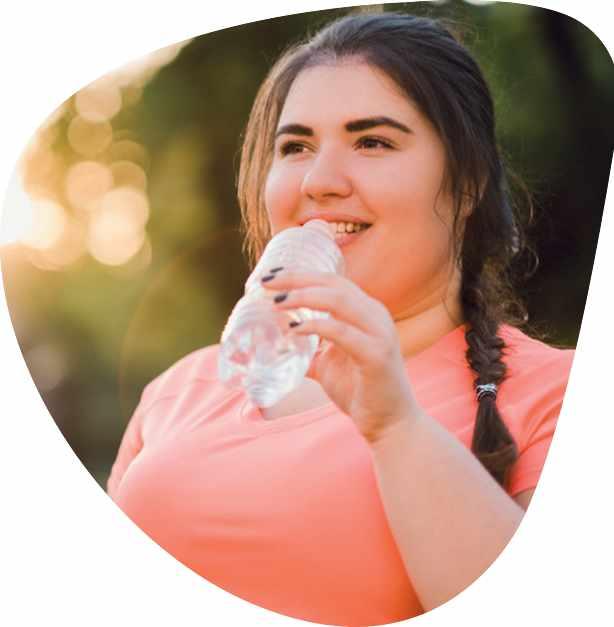
Start your day with a glass of water before anything else – yes, even before coffee – and aim to have a drink with each meal and snack. Keeping a refillable water bottle nearby makes it much easier to sip regularly throughout the day. If plain water doesn’t tempt you, try adding a squeeze of citrus, slices of cucumber, or a few sprigs of fresh mint for a refreshing twist. Herbal teas or hydrating foods like watermelon, cucumber, and lettuce can all help boost your overall fluid intake, too.
We’ve all felt it – when the temperature rises, so does the feeling of sluggishness. That energised feeling that drives your exercise sessions in the cooler months might be replaced with a heavy, tired sensation that makes it hard to get going. As a result, movement drops, and fitness progress can sometimes stall.
On hot, sunny days, take a flexible approach when it comes to how and
when you move. Shift your workout sessions to cooler times of the day, such as early mornings or late evenings which are usually a more comfortable temperature. Choosing lower-intensity exercise like walking, yoga, or swimming can be a good idea on hot days too! Remember, every little bit counts. It’s not about perfection, it’s about keeping your body moving consistently, in ways that feel good to you. Give yourself permission to do what feels manageable – and enjoy it!


It’s easy to think that having less appetite in the heat might naturally support weight loss, but if you’re consistently skipping meals or undereating, your body can end up running on empty. This can result in low energy levels, dips in blood sugar, and stronger feelings of hunger later in the day, which can make it harder to make balanced choices. It can also make it more likely that you’ll overeat without meaning to.

From garden parties and pub lunches to beach picnics and family barbecues, summer often brings more spontaneous get-togethers and celebratory meals, and with them, a lot of high-calorie foods, drinks, and irregular eating patterns. This can be tricky if you’re trying to stay on track with your weight loss goals, but also want to enjoy the moment.
The key here is balance, not restriction. Allow yourself to enjoy these events, but
make mindful choices where you can, without turning it into an “all or nothing” moment. For example, you don’t need to avoid the burger altogether, but try to be mindful of portion sizes and cooking methods such as opting for boiled, grilled or baked items over fried or roasted. Choose drinks you really enjoy, then alternate them with water to stay hydrated and save calories. And don’t feel you have to ‘make up’ for indulgences with restrictions the next day, just return to your usual habits and move on. One meal or one event won’t undo your progress!
Summer can throw your usual structure into chaos, especially if you have children at home, are juggling holidays, or have extended family or friends in your house all day. When your schedule shifts, the routine habits that you rely on during the rest of the year to support your goals, such as meal prepping, set mealtimes, or regular workouts, can easily fall by the wayside.
The solution
Focus on maintaining one or two key
habits each week, even when your regular routine goes out the window. For example, prepping batches of filling snacks ahead of time, sticking to consistent mealtimes, or getting outside for a walk each day. You don’t need a perfect routine, just enough structure to maintain your health priorities. If things do get hectic, don’t panic! It’s completely normal for habits to ebb and flow throughout the seasons. What matters most is returning to those supportive routines when you’re able to.
If your appetite is reduced in the heat, try aiming for smaller, more frequent meals or snacks spread throughout the day. Focus on including a good balance of protein, healthy fats and fibre, which will help to stabilise your energy levels and support appetite regulation. If you’re eating more frequently, it’s important to count your calories in the app to make sure you’re sticking to your calorie target and getting a good mix of nutrients during the day.
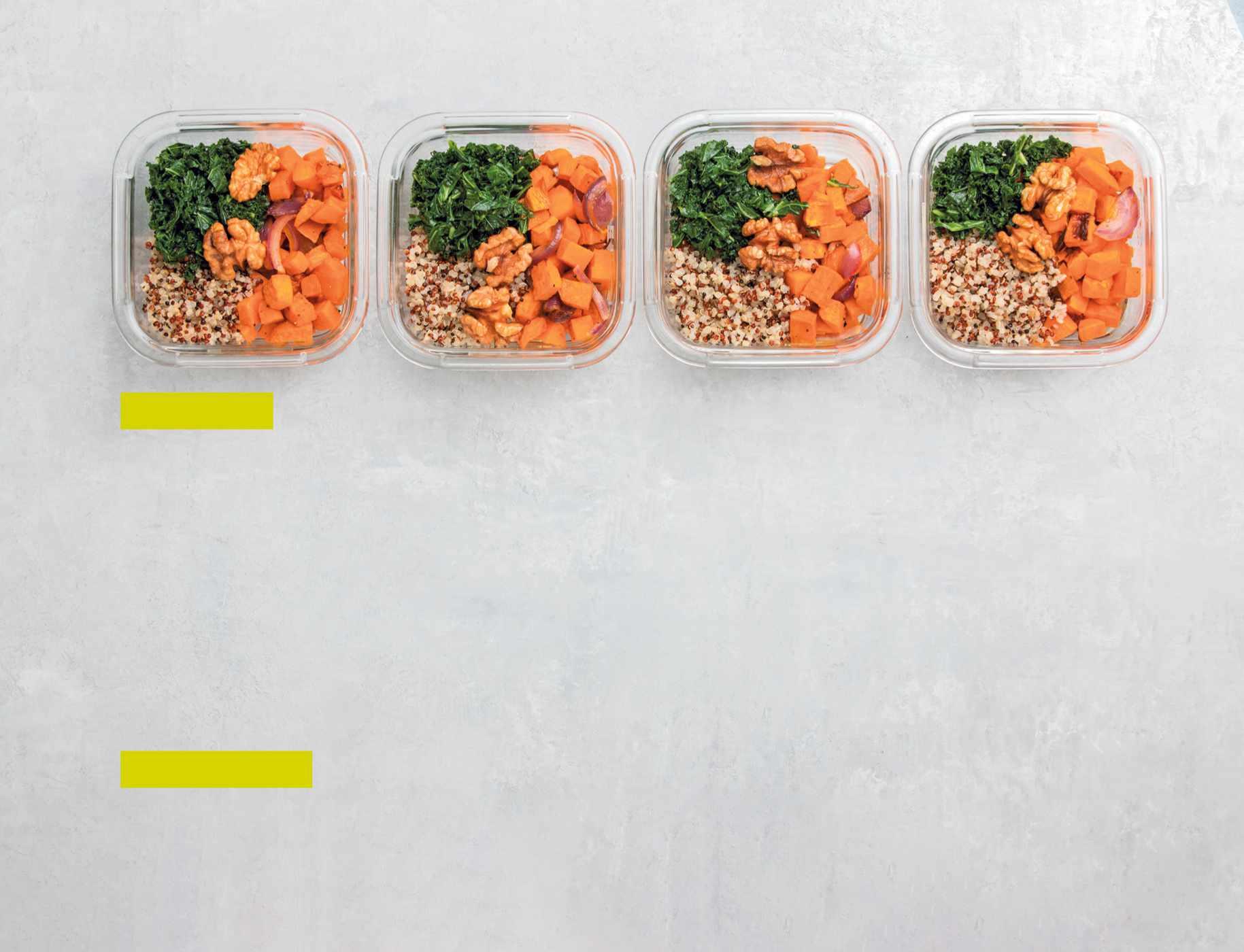


Hot weather can really zap your cooking mojo – especially when the idea of standing over a hot oven or hob feels completely unappealing. You might find yourself grazing throughout the day or relying more on convenience foods. While lighter appetites are normal in summer, unstructured eating can sometimes lead to energy crashes, nutritional gaps, and that unsatisfying feeling of never being quite full.
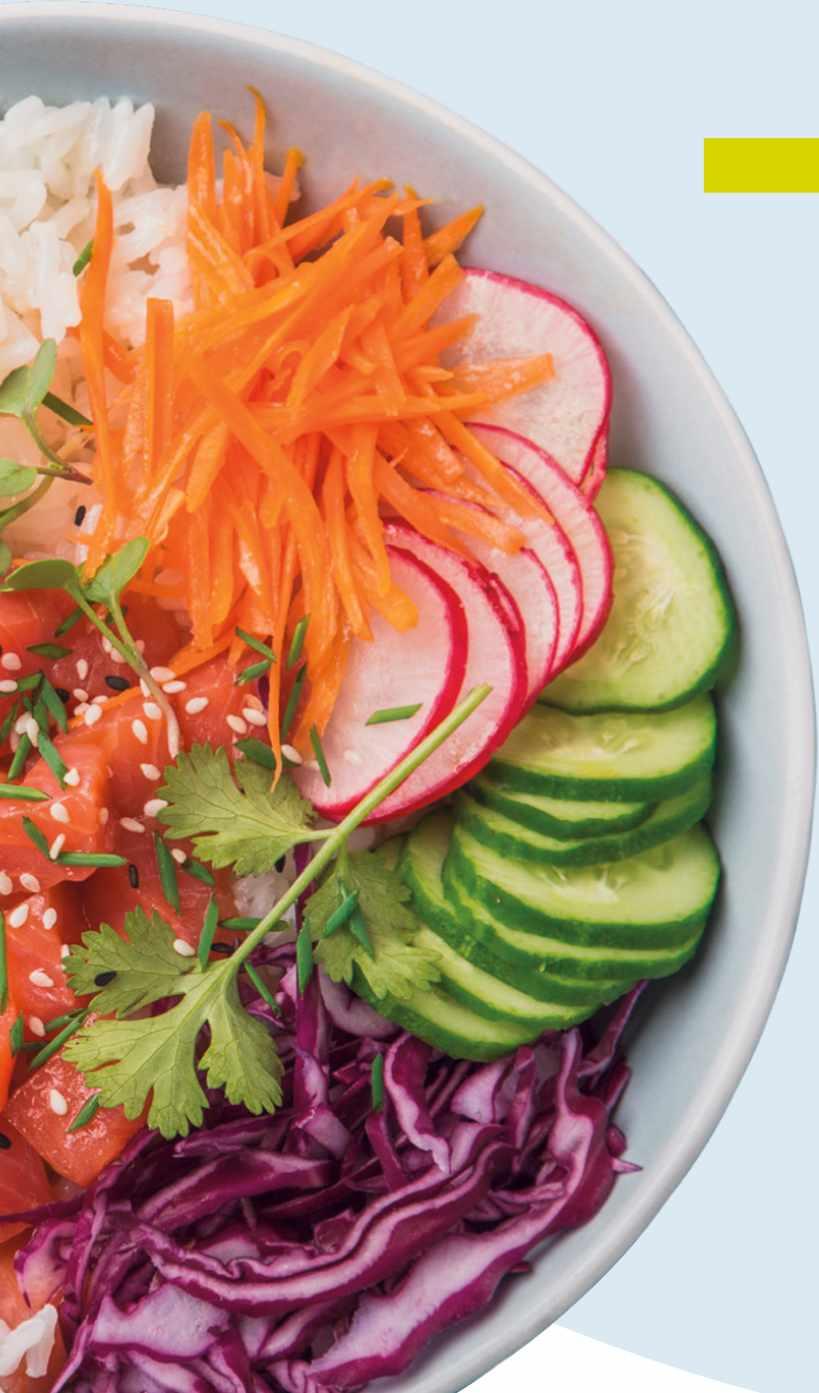
Make life easier with low-effort, nofuss meals that don’t require much (or any) cooking. Try salads with ready-cooked protein and veg, wraps filled with hummus, roasted peppers and spinach, or DIY rice bowls using pre-cooked grains, tinned beans, avocado, and any other toppings you fancy. Having a few ‘graband-go’ meal ideas up your sleeve can help you stay nourished and energised, even when you’d rather be outside than in the kitchen. Try creating a list of go-to meals on your phone or fridge so you’re never stuck for ideas when hunger strikes. For more inspiration, check out our no-cook recipes on P28.
Light evenings, heat, and busy social calendars can all interfere with your ability to wind down and get good-quality sleep. And when sleep is disrupted, your body produces more of the hormone ghrelin (which increases appetite) and less leptin (which helps you to feel full), along with making impulse control more difficult. That makes it harder to manage cravings and keep up your energy levels the next day.
Prioritise sleep just as you would your meals or movement. Keep your bedroom as cool and dark as possible – blackout curtains, an eye mask, and even a fan can help. Try to step away from screens at least 30-60 minutes before bed, and build in a winddown routine that helps you shift into rest mode. This might include a cool bath, gentle stretching, calm music or reading. Quality sleep has a powerful knock-on effect on mood, motivation, and appetite regulation, making it a quiet game-changer when it comes to reaching your weight loss goals.
It’s important to remember that your health or weight loss journey is not just about numbers on a scale. Weight naturally fluctuates throughout the year due to changes in lifestyle, hormones, temperature and summer is no exception. But progress can still happen, even if it looks a little different to what you expected.
Instead of focusing only on weight loss, try shifting your attention to habits, energy levels, and how you feel in your body. Are you sleeping better? Feeling stronger? Less bloated? These are all signs that your efforts are paying off, even if the scale is slower to respond than you’d like.
Summer comes with so much to enjoy, with sunshine, movement, time outdoors, and precious moments to remember with loved ones. While it can make weight management trickier, with a few mindset changes and a realistic approach, it’s completely possible to stay aligned with your goals.
Be kind to yourself, focus on consistency and progress over perfection, and don’t underestimate the power of small, daily wins. After all, your health isn’t defined by a single week or a holiday, it’s built over time, one choice at a time!
With interest in outdoor swimming hitting an all-time high, Sarah Lienard takes a look at its steady rise in popularity, plus the benefits for body and mind
Anyone who’s tried booking a last-minute session at a beloved local lido recently will have got the message loud and clear – al fresco swimming is back, and booming. And with clear water, fresh air, and (hopefully) sunny skies on offer, it’s not difficult to understand the appeal that outdoor swimming holds for so many.
In recent research by The Outdoor Swimming Society, most participants simply stated “joy” as being their main draw to the water, with 94% reporting lower levels of stress and increased feelings of happiness after an outdoor dip. 68% said they swam to improve their physical fitness, while 62% felt that outdoor

swimming made them feel braver or more stoic. Other benefits cited included socialising (68%), a spiritual connection with nature and the self (55%) and a sense of adventure (55%). 1
Of course, for the more adventurous (and confident) swimmers among us, lakes, rivers, and seas offer an exhilarating location to make a splash – and all with no pre-booking required. So why are al fresco dips having a comeback, what makes outdoor swimming such great exercise, and how can you get started this summer?
1 outdoorswimmingsociety.com/oss-survey-results/

While people have obviously been swimming in the great outdoors since long before indoor pools were invented, recent years have seen a rise in the number of people, and women in particular, seeking out the experience. In 2021, Outdoor Swimmer reported that participation in outdoor swimming had tripled over the past two years, with women now making up the majority, at 65%, compared to the previously equal split of men and women in 2017.2
So, why are more people taking the plunge? The pandemic nudged swimmers outdoors – and many never looked back. Plus, rising energy costs and pool closures have only deepened interest in lidos and wild swim spots across the country.
“There has been a steady increase in interest for the past twenty years,” says outdoor swimming expert, Ella Foote, “but the pandemic years gave outdoor swimming a big boost. People started paying more attention to the beautiful natural spaces outside their front doors – and once they experienced the joy of outdoor swimming, many never looked back.”
Another factor that’s driving the rise? The need to escape from the urban environment and our screen-saturated lives, combined with a strong desire to reconnect with nature. Outdoor dips offer an immersive experience that takes us out of the drudgery of day-to-day life and provides a sense of relaxation, adventure, and awe – feelings that many find they are missing out on in modern life. “In these turbulent times, it’s a form of escape that grounds you in the present,” Ella says. “It reminds you of the beauty that’s still around.”
Finally, many of those who have dipped their toes into outdoor swimming keep coming back for the social aspect. Outdoor swimming groups and communities are easy to find, and are a great way to make friends in your local area while building up your confidence in the great outdoors.
2 outdoorswimmer.com/wp-content/uploads/2022/ 04/TrendsReport_Full_LR.pdf
So, what are the benefits of outdoor swimming? Let’s take a look at some of the brilliant things that lido or wild swimming can do for you.

Swimming is gentle on your body, providing a good workout without the intense impact that running or high-impact sports can have on your joints. Practised carefully and with supervision, swimming is particularly wellsuited to those recovering from injuries or managing chronic conditions like arthritis, joint pain, or back issues.
Even short, gentle sessions in the water can help build strength and endurance, without overloading the body – which is especially important if you’re rebuilding fitness or just starting out. And for those recovering from injuries, lidos with lifeguards offer a safe and supportive space to build confidence, with help on hand if you need it.
Outdoor swimming can be a brilliant way to burn calories and support weight management. Because it engages the whole body and requires constant effort, swimming uses a surprising amount of energy – even when it doesn’t feel like a tough workout.
The number of calories burned will depend on your stroke, pace, body weight and the water temperature, but on average, a gentle swim can burn around 150-200 calories in 30 minutes, while a more vigorous session can torch more. Plus, swimming helps build lean muscle mass –and the more muscle you have, the more calories you burn at rest.
And because it doesn’t always feel like traditional exercise – especially when you’re outdoors surrounded by trees, birdsong, or the open sky – it’s easier to stick with, helping to create long-term healthy habits without the dread factor.
Want to know the average calorie burn you can expect per 30 minutes of exercise?
Take a look at these stats:
During swimming, your entire body works against the resistance of the water, helping to strengthen your arms, core, back and legs. It’s also a great way to improve posture and flexibility over time.
The best part? You can adjust the intensity to suit your needs – from a gentle float and paddle to an energetic, heart-pumping workout. That makes it ideal whether you’re just getting started with fitness or looking to cross-train alongside other activities.
Studies show swimming – especially outdoors –significantly boosts mood and reduces stress levels. The rhythmic motion, fresh air and natural surroundings provide a meditative escape, promoting feelings of calm and well-being.
Many outdoor swimmers report a noticeable mental lift after a dip – and there’s some science behind it. Cold water immersion is thought to trigger the release of endorphins (feel-good hormones), as well as boosting dopamine levels, which are linked to improved mood.3
“You have to breathe in a measured way, which forces you into your body and into the present,” explains Ella. “With wild swimming, you often can think of nothing but the elements you are faced with – wind, rain, weeds, cold water – thoughts of work or relationships are gone!”
Over time, regular dips can build mental resilience and increase your ability to cope with
stress – something that many outdoor swimmers say becomes just as valuable as the physical benefits. In fact, many turn to the water for its grounding effect – a chance to reconnect with themselves and switch off from everyday worries. “Swimming is quite a meditative movement,” Ella says. “The rhythm helps our minds sort through their mental mess. If I’m caught in a problem, I can often find the answer after a swim.”
And let’s not forget sleep. Like all exercise, swimming can help improve sleep quality and duration – but many find the combination of physical exertion, fresh air and nature especially helpful.4

Think they don’t exist for adults? Think again! Whether you’re learning for the first time or brushing up your technique, adult lessons are widely available, and a great way to build up confidence. Most leisure centres offer group or one-to-one sessions to suit your pace. It’s never too late to dive in – and you might be surprised how fun it is.
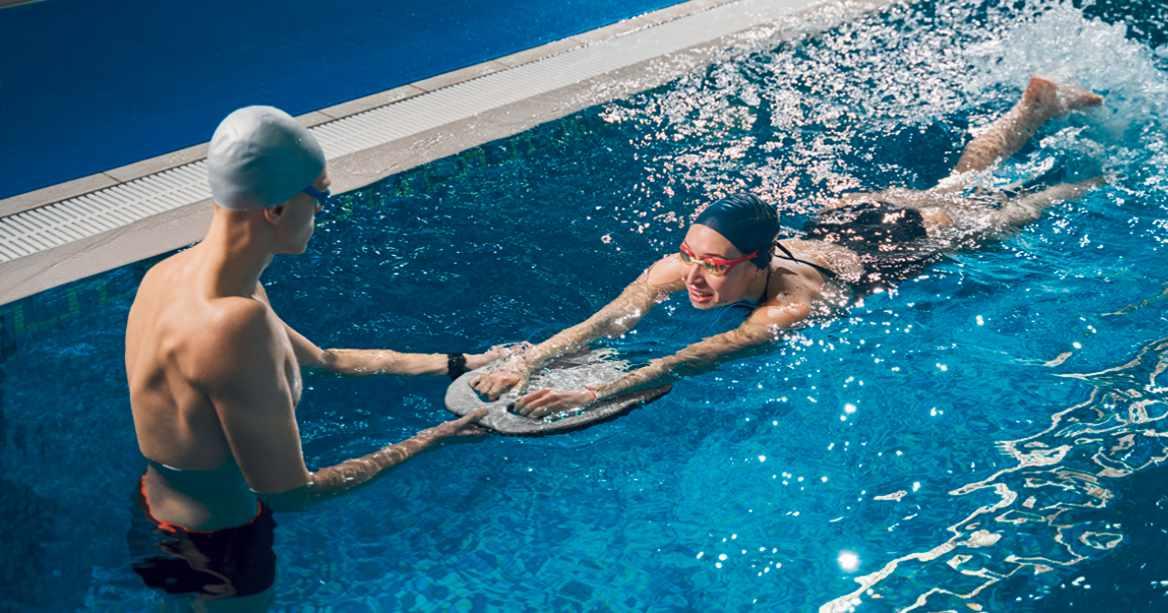
Ella agrees that safety and skill-building come first: “Ask yourself – how comfortable are you out of your depth? Can you swim for 25 metres without stopping? Can you tread water or float on your back? These basic skills could save your life, so if you are unsure, focus on these first.”
Swimming solo can be a calming, mindful experience –but if you’re new to outdoor swimming, having company can boost both confidence and safety. Look for local swim groups in your area (Facebook, forums, and community notice boards are great places to start). Many groups welcome beginners and offer social swims, safety tips, and plenty of encouragement. You’ll likely find that chatting before and after a swim becomes just as enjoyable as the swim itself – and having a swim buddy makes it much easier to stay motivated.
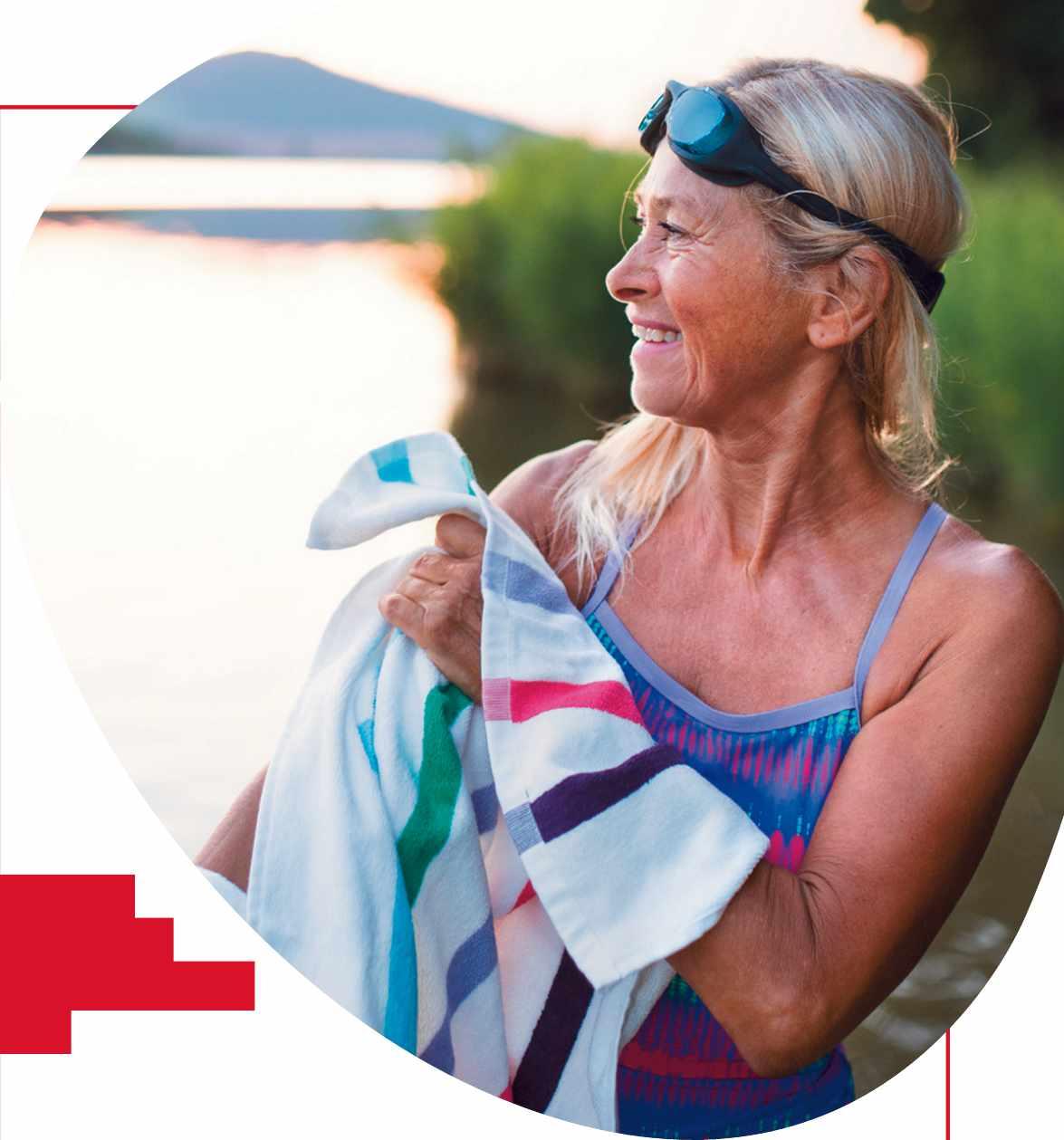
Swimming is refreshingly low-maintenance compared to many sports. “You only really need a swimsuit and towel,” says Ella, “but goggles can make a big difference. A bright swim cap and tow float help you stay visible, and something on your feet can protect them from sharp stones or slippery spots. And even in summer, pack warm
layers for afterwards.” For open water swimming, you might also consider earplugs (to help prevent swimmer’s ear), a microfibre towel, and a waterproof bag for your gear. In colder conditions, neoprene gloves, socks or water shoes can help keep extremities warm and give you better grip underfoot.

Tracking your swims can be a great way to stay motivated, especially as you start to notice improvements in stamina, technique or confidence. Many smartwatches and waterproof fitness trackers can log your swim distance, pace and heart rate – and some can even record open water routes using GPS. If you’re using the Nutracheck app, you can sync your fitness tracker to log calories burned from your swim sessions automatically. Watching your progress build week-by-week can be just the push you need to keep going.
Outdoor swimming is exhilarating and joyful, but safety is key. A few basic precautions can boost confidence and lower risks.
Know your limits –and respect them. It might sound obvious, but it’s the golden rule. Don’t swim further, faster or longer than feels right, especially in cold or unfamiliar water. Tiredness hits quicker outdoors, so listen to your body and get out while you’re still feeling good.
Check the conditions. Before swimming, scan your surroundings. Watch for signs of strong currents, tides, or slippery rocks, and avoid areas with algae or pollution warnings (local councils or swim groups often share updates). At the beach, check tides, waves, and lifeguard presence. If in doubt, don’t get in.
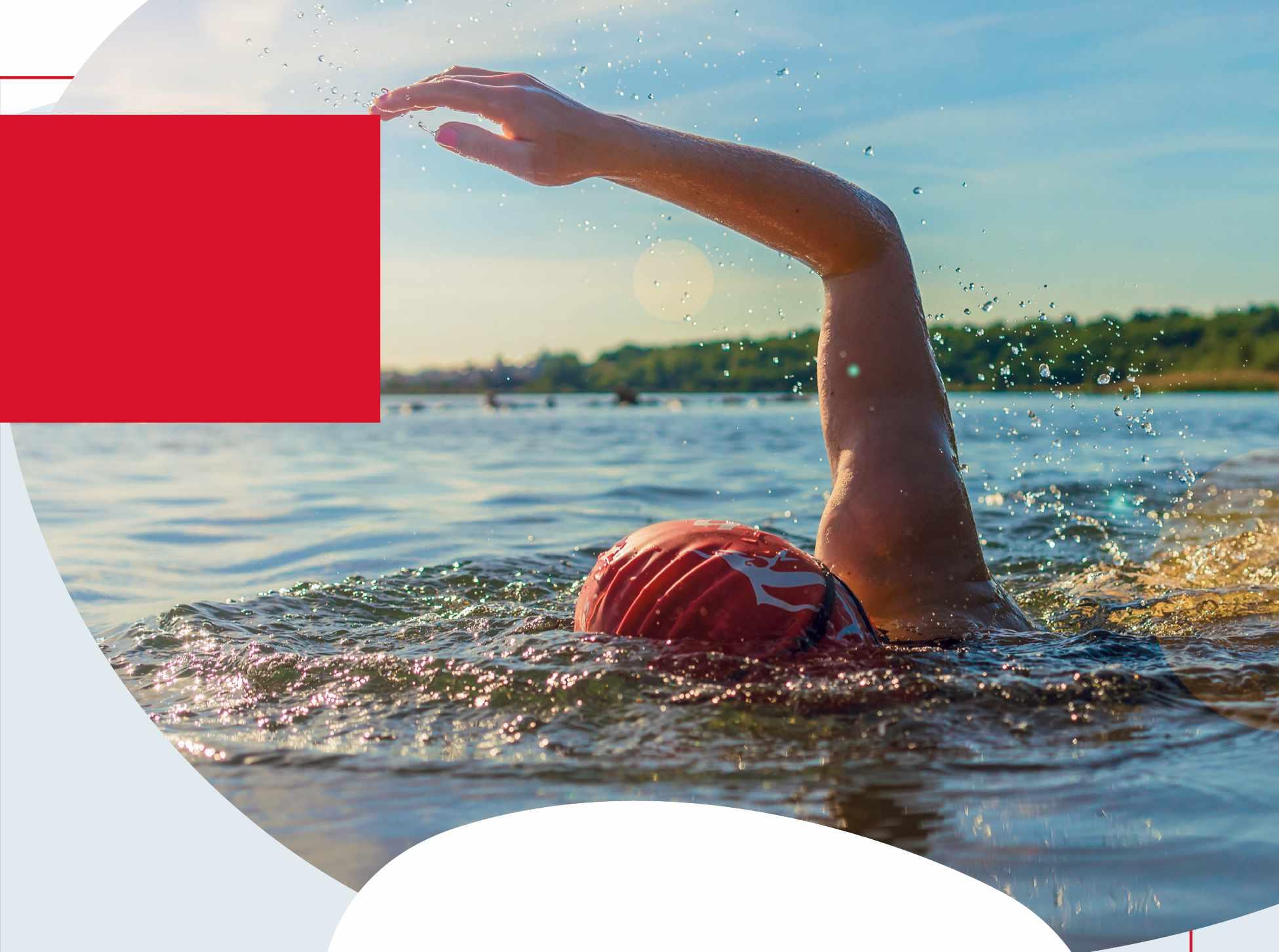
“Water can fool you,” adds Ella. “It might feel warm in the shallows, but it can be much colder at the bottom. That sudden temperature shift can cause cold water shock –so take it slow, and ease in gradually.”
Stick to known swim spots, lidos, lifeguarded areas or established locations, especially when you’re starting out. “If you’re visiting the coast, find a lifeguarded beach,” Ella says. “If you choose something more remote or quieter, remember that the weather is more changeable in coastal areas, and wind can make a huge difference to how the sea behaves. Check the tide times and for any known offshore currents. As a rule, avoid reservoirs and quarries, which are often private and not designed for swimming. However, lakes in national parks across the UK are wonderful.”
If you’re swimming in open water, always let someone know where you’re going and when you expect to return. Better yet, bring a buddy or join a local group – it’s safer, and more fun too.
Stay warm afterwards. Getting cold after a swim can happen surprisingly fast, even in summer. Pack warm layers, a hat, and a hot drink for afterwards – and change quickly out of your wet swimsuit. A big changing robe or dry robe can make all the difference on cooler days.
Outdoor swimming comes with risks, even for experienced swimmers. Always make sure that you carry out your own assessment of the area that you are swimming in. Check the weather and tides, exercise caution when swimming alone, and only ever swim when you’re feeling well. If you have any doubts about the safety of a location or your ability to complete a swim, it’s best not to take part.
Where can I find more information?
The Outdoor Swimming Society (OSS) Wild swim advice, safety tips and seasonal info –outdoorswimmingsociety.com
Wild Swimming UK
Find scenic spots nationwide – wildswimming.co.uk
Bluetits Chill Swimmers Inclusive, fun-focused swim community – thebluetits.co
Local Facebook groups & community forums FInd local swim spots, new friends, and updates.

About Ella Foote
Ella Foote is Editor of Outdoor Swimmer magazine and Director of Dip Advisor, a swim guiding business. She’s an open water coach, RLSS lifeguard and author of How to Wild Swim. Ella regularly writes for national media and swims year-round in rivers, lakes and seas across the UK and beyond. Find out more at thedipadvisor.co.uk, or follow Ella on Instagram at @dip_advisor.


save calories (and taste just as good!)
Love a sizzling summer BBQ? With a few clever food swaps, you can enjoy plenty of flavour while keeping an eye on your weight loss goals
Barbecue season doesn’t have to throw your healthy habits off course. Whether you’re hosting or heading to a friend’s garden, these easy food swaps can help you cut calories without missing out on your favourites.
SWAP BEEF BURGERS FOR TURKEY BURGERS
This simple swap saves around 100 kcals per patty!
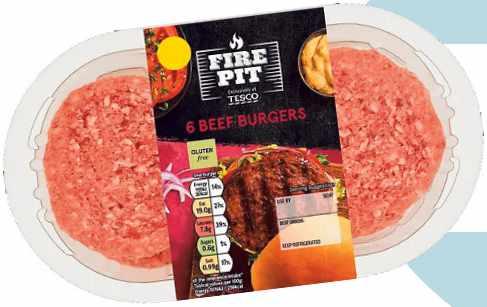
Instead of: Tesco Fire Pit Beef Burgers

Try: Tesco Turkey Burgers
SWAP PORK SAUSAGES FOR CHICKEN OR QUORN SAUSAGES
Alternative picks that are lower in fat, but just as satisfying.

Instead of:

SWAP BBQ RIBS FOR LEAN GRILLED STEAK Ribs can clock up calories fast, so opt for lean steak instead.

Instead of: Asda Slow Cooked Sweet BBQ Pork Rack of Ribs
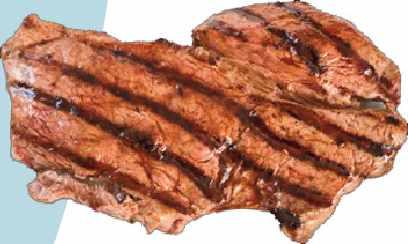
Try: 8oz Barbecued Lean Beef Rump Steak
SWAP COLESLAW FOR CITRUS SLAW
A zingy, fresh side dish that’s lighter on the calories.
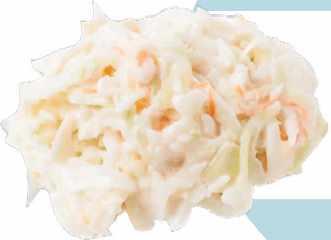
Instead of: Creamy Coleslaw

Try: Asda Zingy & Vibrant Pickled Pink Slaw
SWAP ICE CREAM FOR FROZEN YOGHURT
Get a sweet scoop for far fewer calories.

Tesco Finest Pork & Caramelised Onion Sausages Quorn Sausages
Try: Aldi Ashfields Garlic & Herb Chicken Sausages
SWAP CHICKEN WINGS WITH SKIN FOR SKINLESS CHICKEN BREAST SKEWERS
Skinless chicken = fewer calories and leaner protein.
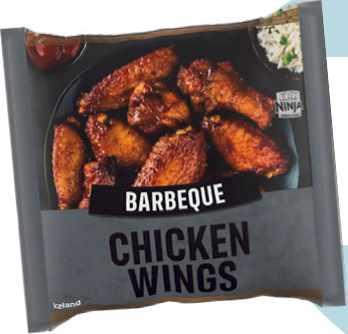
Barbecue Chicken Wings
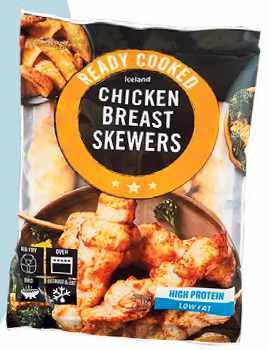
Skewers
Instead of: Ben & Jerry’s Cookie Dough Ice Cream

Try: Morrisons Mango & Passion Fruit Frozen Yogurt
SWAP CREAMY POTATO SALAD FOR BAKED SWEET POTATOES
Equally as filling, but lighter and naturally sweet.

Instead of: Tesco Potato Salad
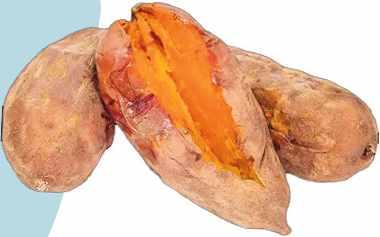
Try: Baked Sweet Potatoes
Alternatively, try our healthy potato salad on p21…
The way we think about food is just as important as what’s on our plate. Here’s what works for our nutritionists to stay balanced, motivated, and positive
Ever wondered how nutritionists really feel about food, and their bodies? Do they genuinely enjoy eating healthy food every day? And do they ever struggle with body image like the rest of us? Here, Nutracheck nutritionists Emma and Beth share their personal journeys to a healthy mindset, plus the secret tips and tricks that help them stay balanced.
The ‘why’ of everything we do in life is hugely important. If your reason for eating a big bowl of salad is simply because you think it’s good for you, but you don’t actually enjoy it, chances are that reason won’t be strong enough to keep your motivation up for long. When we’re aiming to create a positive mindset
towards food and our body, our reasons for making the choices we do really matter. If we force ourselves to exercise just because we want to lose weight, it can start to feel like a punishment.
A positive mindset towards our health stems from positive reasons for doing things. Exercising because we feel a mental boost afterwards
We don’t need to eat ‘perfectly’, we just need to eat with intention” “
or eating a healthy, hearty breakfast because it makes us feel alert and energised for the day ahead – these are reasons that can continue to motivate us.
What we want is to make choices through intention. Try to choose foods because of what they offer you and your body, not just because they’re traditionally considered ‘healthy’. When we recognise how individual foods benefit us, it becomes much easier to naturally choose those foods. We can then view food as the friend and not the enemy. Similarly with exercise and body image, trying to focus on what the movement is doing for our body and the amazing things our body
does for us each day, can really help with creating a positive relationship with exercise.
The goal is to get to a place where we feel relaxed and flexible around our food choices, naturally choosing nourishing foods a lot of the time, and avoiding any feelings of guilt when we indulge a little. We don’t need to eat ‘perfectly’, we just need to eat with intention –a mixture of foods that are good for the body, and foods that are good for the soul.
NUTRACHECK’S PHILOSOPHY
With Nutracheck, flexibility is key. No banned foods, no strict rules. The food diary simply shows what foods contain, so you can make balanced choices.
Here’s how I keep that positive relationship with food and my body…

Monday to Friday, I choose foods for their nutritional benefits. I’m mindful of what goes into each meal and how it supports my body. For example, my overnight oats include berries, nut butter, seeds and yogurt – each chosen for fibre, protein, healthy fats, and vitamins. I plan my dinners in advance to include oily fish, varied proteins, vegetarian options, and different vegetables and carbs. My choices aren’t random – they’re intentional, with a focus on variety and balance.
I keep weekends more flexible, rarely plan meals, and eat on the go. My focus shifts from nutrients to enjoyment. While both can align, on the weekends, I choose whatever I really fancy in the moment, rather than making strategic nutritional choices.
This weekly balance helps me to eat well most of the time without feeling deprived. I genuinely enjoy healthy food and knowing it supports my body – but I also love to eat the not-so-nutritious-stuff sometimes too, simply because it tastes good.
It’s easy to get caught up in how we look, but I’ve learned that appearance-based goals rarely bring real happiness. These days, I intentionally choose to set goals that are all about how I feel. I want to lift heavier to feel stronger, and I want to run faster and further to feel fitter. These goals keep me motivated because they’re measurable and meaningful.
I also have a four-year-old daughter and it’s so important to me to be a positive role model to her. I try to only ever talk about my body positively, not just in front of her, but always. We all have days where we feel a little self-conscious, but positive self-talk really helps shift that inner voice towards kindness.
Emma White
Nutritionist Emma White (ANutr), MSc Human Nutrition is passionate about how food science applies to the human body, and how the nutrients in what we eat affect us and ultimately have an impact on our health.
When it comes to the foods we eat, try to notice what they will offer you, not what they don’t. Think about the nutrients they contain, or how the energy will sustain your body.
If there’s food you really don’t like or exercise you truly don’t enjoy, steer clear. There is so much variety in this world that we don’t have to do everything that’s considered healthy for us – we can pick the things we actually connect with.
Positive affirmations can really help to shift any potentially negative inner voice. Set the tone each day with compassionate words – this can really help you to make positive food and movement choices for yourself.
Comparison is the thief of joy (as they say), so try to challenge that nature of comparing to everyone around you. We don’t walk in anybody else’s shoes all day every day, so assuming we should think, act, or be the same as others is neither helpful, nor healthy.
The language we use to describe food is important. Foods aren’t moral choices – they just serve different purposes, and offer different things. Labelling foods as ‘bad’ can heap on the guilt and shame, which we want to avoid.
Social media is full of people promoting fad diets and sharing what they eat each day, but it’s important to be mindful that what works for one individual won’t necessarily work for another. Plus, we are only ever getting a snapshot with social media, so try not to hold yourself to standards that may not be realistic. Stick to the basics – track your food and aim for a balanced and varied diet, with no banned foods.
Here’s what helps me to feel positive and balanced…

I’ve always been a foodie – I just love food! But growing up, that love sometimes felt overwhelming. I was always thinking about food, even if I wasn’t hungry, and that often led to overeating. One of the most powerful shifts I’ve made has been learning to build real self-awareness.
Now, if I catch myself reaching for food when I’m not hungry, I pause and check in: what’s actually going on here? Am I feeling anxious, tired, bored, or just seeking comfort? Understanding those emotions has helped me to break old patterns. It’s not about judging myself, it’s just about getting curious. And a big part of that curiosity has been learning what fullness actually feels like for me – recognising the difference between physical and emotional hunger, and giving myself permission to stop when I’ve had enough.
One practical tip I’ve learnt is focusing on adding to meals instead of taking things away. Fibre, protein, and healthy fats are now my foundation. These foods keep me fuller for longer and give me steady energy throughout the day. What I once saw as a lack of willpower – feeling hungry not long after eating – was actually just a sign that my meals weren’t satisfying enough. Now, I build meals with whole grains, lean proteins, fruits, and veggies, and feel more fuelled and balanced. It’s not about restriction, it’s about asking: what can I add to this meal to make it work better for me? That simple shift has made my mindset around food so much more positive and supportive.
One of the biggest mindset shifts I’ve made is letting go of the idea that I have to eat ‘perfectly’ all the time – even as a nutritionist! Life isn’t predictable. Some days are spontaneous or less balanced, and that’s OK. Instead of spiralling into guilt, I remind myself that one meal never defines the bigger picture. A flexible mindset helps me make choices that feel good, without the pressure of perfection. I’ve learned that consistency matters more, and the less rigid I am, the more sustainable everything becomes.
Beth Furness
Nutritionist Beth Furness (ANutr), holding a BSc in Nutrition and Health, is deeply dedicated to applying evidence-based knowledge to all aspects of nutrition. Her passion lies in fostering healthy relationships with food, ensuring that everyone maintains a balanced and sustainable approach to nutrition. Beth’s
DO’S & DON’TS
Meal planning doesn’t necessarily have to mean strict schedules or hours in the kitchen for everyone. It’s simply about being prepared in a way that works for you, whether that’s a full weekly plan or just knowing you’ve got a few easy meals on hand. A little forethought can go a long way in keeping food choices stress-free, especially when life gets busy.
Pay attention to hunger, fullness, and satisfaction, not just the clock or what a meal ‘should’ look like. The more you tune in, the easier it gets to eat in a way that actually feels good.
Whether it’s choosing a more balanced breakfast or pausing before emotional eating, those little moments matter. Progress is built in the small, consistent actions –not sweeping changes overnight.
Be mindful of the ‘I’ll start again on Monday’ mindset – it can easily trap you in an all-or-nothing cycle that’s tough to maintain. It often plants the idea that you’ve somehow ‘failed’ and need to wipe the slate clean, when really, it’s just another day! Don’t put too much pressure on tomorrow. Instead, focus on making one small, helpful choice in the moment. Real progress comes from what you do consistently, even when things feel a bit ‘off track’.
Skipping meals even though you are hungry might seem like a quick fix to reduce calories, but it can often backfire. Your body is clever, it knows when it needs fuel, and ignoring those signals can lead to feeling out of control later on. That’s when it’s easy to grab whatever’s closest, not because you’ve done something wrong, but because you’re just running on empty. Eating regularly and responding to your hunger helps keep things steady and stops that chaotic feeling around food.
DON’T Let one moment derail you
You don’t need to ‘start over’ just because one meal wasn’t ideal, every choice is a chance to support yourself, not punish yourself.
Big on taste, low on alcohol – we sipped, swirled and scored dozens of low and noalcohol drinks to find the standout bottles and cans you’ll actually want to share
Whether you’re cutting back, cutting out, or just testing the waters, low and no-alcohol drinks are firmly in the spotlight –and it’s easy to see why. They’ve got the look, the fizz, and the flavour of your usual favourites, minus the hangover and extra calories. We taste-tested 25 options, all

Fresh, zippy, and surprisingly grown-up
White wine lovers, this is the one to beat. Bright, juicy, and subtly floral, Noughty Blanc is clean and uncomplicated in the best way. Serve it ice cold and sip slowly. Plus, with 14 calories and just over 2g sugar per 100ml, it’s a savvy pick for warm-weather sipping.

under 0.5% ABV, scoring each one for appearance, aroma and taste. Our top picks? We chose the drinks that genuinely impressed –from chilled-out whites and BBQfriendly reds to beers that’ll fool even your fussiest mates. Here’s what deserves a place in your summer fridge.
Eisberg AlcoholFree Pinot Noir
Light, juicy, and ready for red-lovers
This one’s a quiet winner. With its soft berry notes and a decently dry finish, Eisberg’s Pinot Noir skips the heavy, syrupy vibe that haunts a lot of alcoholfree reds. Slightly chilled, it’s an easy pour to serve alongside steak dinners. And at 14 calories per 100ml, it’s a great option for calorie-counters.

ROSÉ Wednesday’s Domaine Élan
Dry, delicate and picnic-perfect
Pretty in the glass and just as lovely on the palate, Élan brings notes of wild strawberry and soft citrus with a slightly sour tang that brings a complex finish. It’s dry, elegant, and doesn’t try too hard – which is exactly what we want from a rosé. At under 10 calories per 100ml, it’s ideal for light lunches and lazy garden afternoons.

Don’t let the ABV fool you – this hazy IPA has serious flavour. Bright citrus meets gentle bitterness in a golden, lightly cloudy pour. It was our top scorer overall for the beer category, and with only 53 calories a bottle and barely any sugar, it’s the one we’ll be reaching for all summer long.










n





Amber ale with a twist
This one’s a little different –it leans amber, with toasted malt and a slightly caramel note balanced by citrus hops. It’s flavourful without being heavy, and works well with BBQ dishes or spicy food. It comes in at a slightly higher 90 calories per bottle, but the fuller taste earns its place on our list.
BEST SPARKLING ROSÉ
Wednesday’s
Domaine Cuvée
Party-ready with a floral twist
This one’s made for toasts and clinking glasses. Bursting with aromatic notes of citrus, elderflower and just a hint of ginger, Cuvée feels like a celebration – without the sugar crash. At just under 11 calories per 100ml, it’s bright, bubbly, and beautifully balanced.

Peroni Nastro Azzurro 0.0%

Birra Moretti Zero unny-day lager with m








All the elegance, none of the ABV









Golden, crisp and lightly bready, this one holds up ell against the original It’s got a clean malt profile, gentle fizz and a sweetness that doesn’t linger. Pair it with pizza, BBQ, or just a patch of grass. Around 20 calories per 100ml – easy on the waistline, heavy on r







G 0 Cr amy, dark, and surprisingly






Yes, it’s unmistakably Guinness – but alcoholfree. Our tasters noted that it pours with the same thick head and dark ruby hue as the real deal. On the palate, it’s roasty with notes of coffee and chocolate, and the smooth texture is bang on. About 17 calories per 100ml, and sugar is low too.
BEST SPARKLING WHITE
Eisberg Sparkling
Blanc de Blancs
Classy fizz on a budget
For fans of Champagne who are cutting back, this one delivers a clean, fruity pop. Green apple and juicy pear take the lead, with tight bubbles and a dry-ish finish. Affordable, cheerful, and just 14 calories per 100ml. Chill it well, serve in tall glasses, and enjoy the fizz without the fog.

A solid performer with a light, floral aroma and balanced flavour. It’s got that signature Italian sharpness and a dry finish that feels more premium than most low-alcohol lagers. Smooth and subtle, this is a great allrounder. Around 23 calories p .


Corona Cero Beach vibes in a bottle
Refreshing, light-bodied and very drinkable, Corona Cero is made for sunshine. A slice of lime in the neck? Still essential. It has a subtle malt base with a hint of sweetness, and clocks in at around 56 calories per bottle. Crisp, cool and classic.
BETH FURNESS SAYS:
“Swapping to low or no-alcohol drinks can really reduce your calorie intake, and cutting back brings a whole host of other health benefits, too. Alcohol itself is calorie-dense, and many alcoholic drinks also contain hidden sugars. Most of the options we’ve featured come in at half the calories (or less) of their alcoholic equivalents, but keep an eye on the label – especially with wines, which sometimes add sugar to balance flavour. Choose carefully, enjoy in moderation, and remember to log your drinks on the Nutracheck app.”
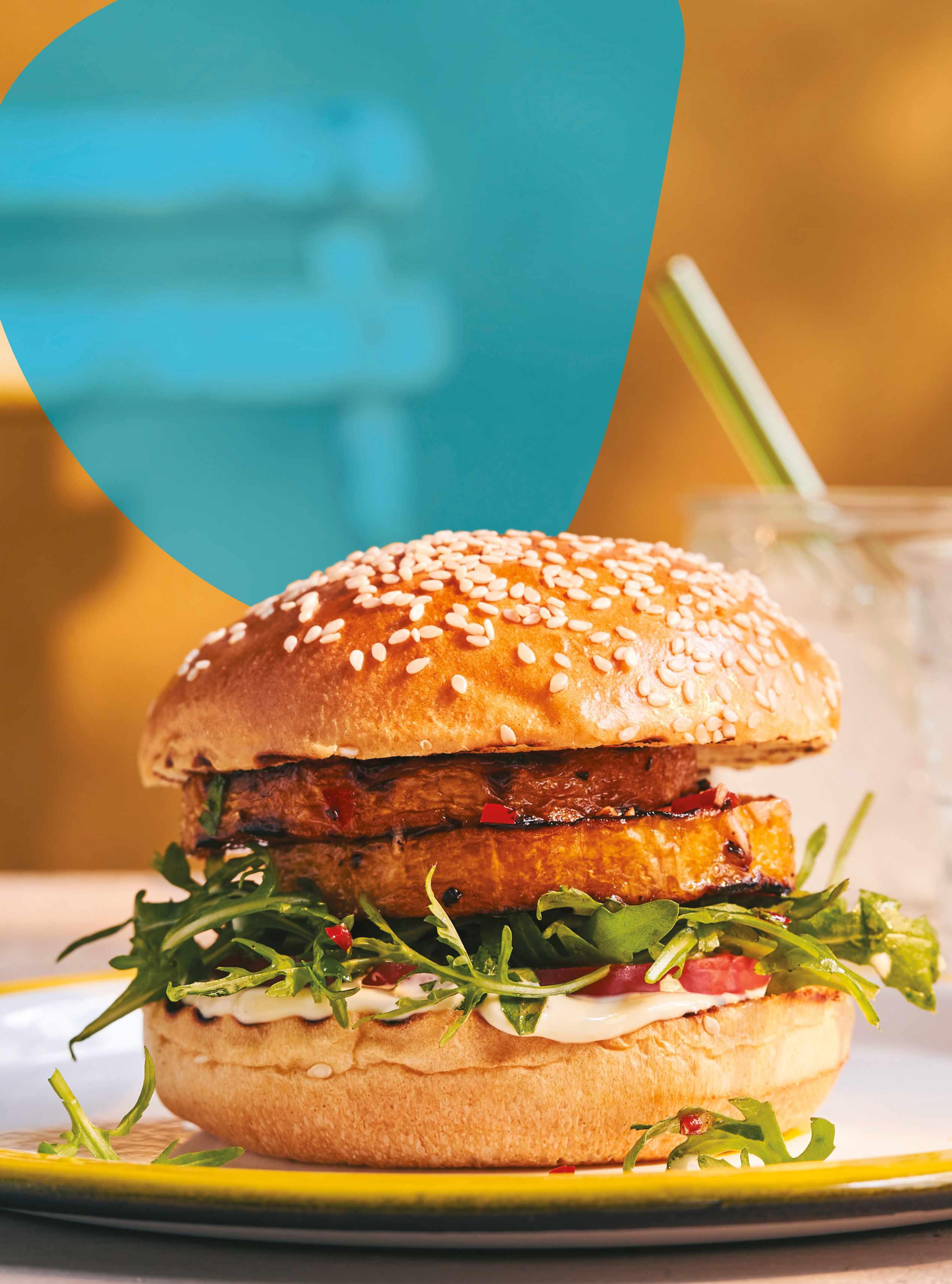
Whatever the weather’s doing, these caloriecounted recipes are ready to go. Fire up the barbecue when the sun’s out – or bring the flavours indoors using the grill or oven. Either way, you’ll end up with something fresh, satisfying, and perfect for summer
Hearty and full of warming spices, these meat-free burgers are a flavourful twist on a summer classic. Serve them in buns with your favourite toppings –they’re vegan, satisfying, and totally grill-friendly
PER SERVING 426 kcals | fat 21g | saturates 3g | carbs 47g | sugars 6g | fibre 4g | protein 10g | salt 1.2g
SERVES 4 PREP 20 mins COOK 20–30 mins EASY VEGAN
1 butternut squash (choose one with a long neck, if you can)
1 red chilli, finely chopped
1 large garlic clove, finely grated
2 tbsp garlic-infused oil
small handful of parsley, finely chopped handful of rocket
4 burger buns (ensure vegan, if needed)
4 tbsp mayonnaise (ensure vegan, if needed)
1 large tomato, sliced into 4, to serve
1 Cut the squash in half where the neck meets the bulbous part. Reserve the bulbous part for another recipe. Trim the stem at the top of the neck, then carefully slice into roughly 1cm discs – you should get about eight, depending on the length. Set aside
2 Combine the chilli, garlic and oil with a pinch each of salt and ground pepper in a small bowl.
3 Light the barbecue and wait until the coals are ashen. Brush one side of the squash discs with the chilli and garlic mixture, then season with salt. Cook oiled-side down for 10 mins, closing the barbecue if you can and basting with more of the chilli and garlic mixture every few minutes until the discs begin to soften. Flip over, brush with more of the chilli and garlic mixture, and cook for a further 10-15 mins, continuing to baste as before. Once tender and slightly caramelised, they are ready. Toss the parsley and rocket in the remaining chilli and garlic mixture.
4 Serve two squash burgers per bun, also filled with some of the dressed rocket and parsley leaves, a spoonful of mayo and a slice of tomato.
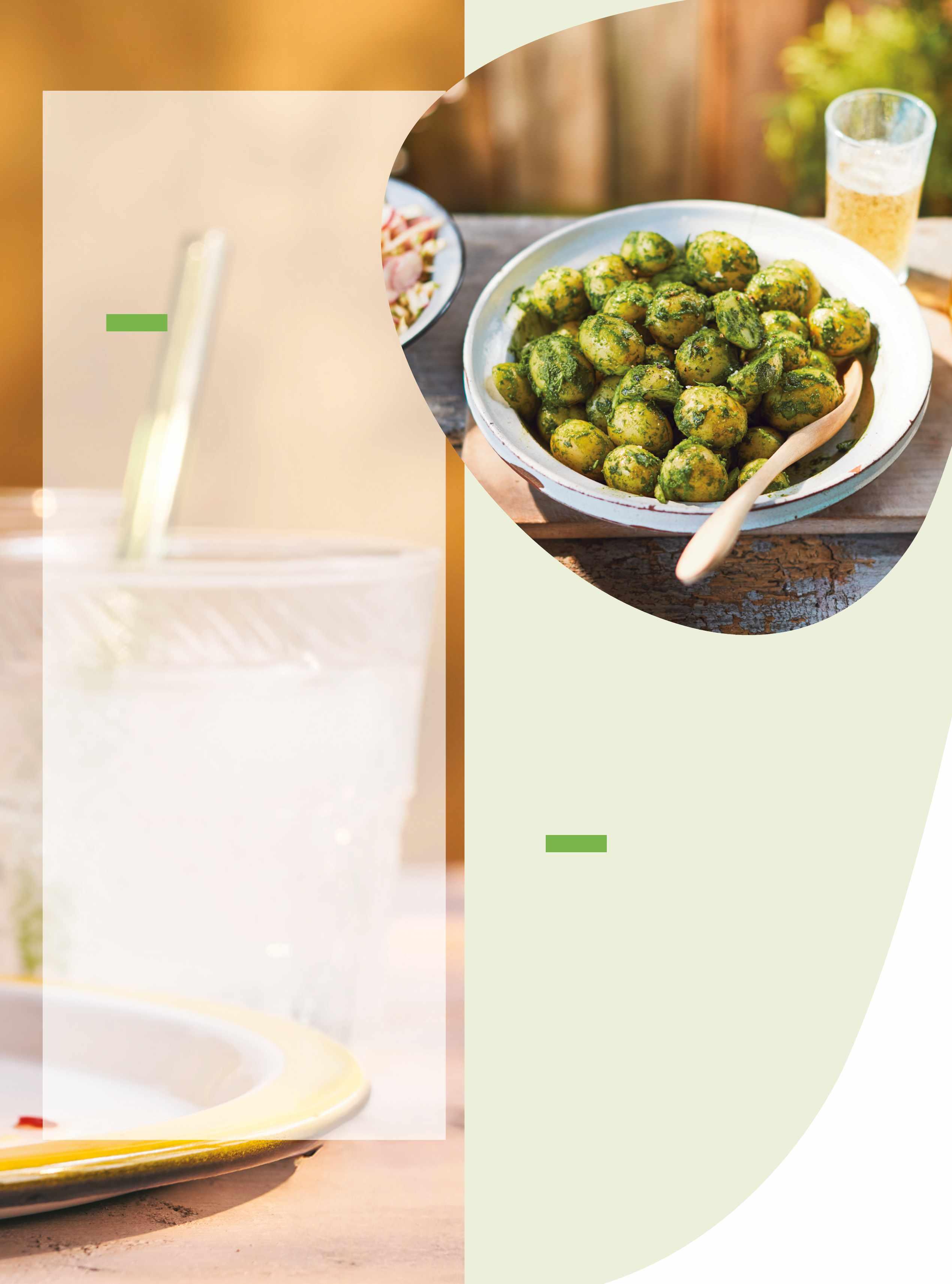
If the weather’s not cooperating, heat a frying or griddle pan over a medium-low heat. Brush one side of each squash disc with the chilli and garlic mixture as before, and cook for 15 mins, until slightly charred and starting to soften. Turn over, baste again and cook for 10-15 mins more until tender and slightly charred.
This fresh, zesty potato salad is tossed in a vibrant basil and parsley dressing. Light, herby and vegan-friendly, it’s the perfect side for anything hot off the grill (or fresh from the oven)
PER SERVING (10) 168 kcals | fat 10g | saturates 2g | carbs 15g | sugars 1g | fibre 3g | protein 3g | salt 0.2g
SERVES 8-10 PREP 10 mins COOK 30 mins EASY VEGAN
1 large bunch basil
1 large bunch parsley
1kg new potatoes, larger potatoes halved
100ml extra virgin olive oil
2 tbsp white wine vinegar
1 small garlic clove
1 Bring a large pan of salted water to the boil, drop in the basil for 30 secs or until wilted, then fish out with a slotted spoon and set aside to cool slightly. Add the potatoes and cook until tender.
2 Meanwhile, squeeze out the basil over the sink, then put in a blender along with the oil, vinegar, garlic and a good pinch of seasoning. Blitz until you have a vibrant green oil.
3 Drain and steam-dry the potatoes. Chop the parsley, then tip it and the potatoes into a serving bowl. Season and toss in the basil oil. Will keep for two days.
These smoky skewers are packed with flavour thanks to a spiced buttermilk marinade. Paired with ribbons of courgette, they’re easy to prep, quick to cook, and perfect for popping on the barbecue or under the grill
PER SERVING 330 kcals | fat 17g | saturates 5g | carbs 4g | sugars 4g | fibre 1g | protein 40g | salt 1.2g
SERVES 4 PREP 30 mins
COOK 15 mins, plus at least 2 hrs chilling EASY
200ml buttermilk
1¼ tsp sweet smoked paprika
½ tsp Aleppo pepper 800g skinless, boneless chicken thighs, quartered 2 courgettes, trimmed ½ lemon, juiced
YOU’LL ALSO NEED 4 metal skewers (or soak wooden skewers in water for 30 mins before using)

1 Combine 150ml of the buttermilk with 1 tsp of the paprika, the Aleppo pepper and ¼ tsp sea salt flakes. Add the chicken pieces, mix well to coat and chill for 2 hrs, or overnight.
2 Meanwhile, slice the courgettes lengthways into 8-12 thin ribbons each using a vegetable peeler. Sprinkle over ¼ tsp sea salt flakes and leave to soften for 15-30 mins.
3 Combine the remaining 50ml buttermilk and paprika with the lemon juice in a small bowl or jug. Set aside.
4 Alternately thread the chicken and courgette ribbons, folding them in a concertina effect onto the skewers –each skewer should have a quarter of the chicken on it. Cook on the barbecue over a moderate heat or ashen coals for 10-15 mins, turning regularly to ensure they char but don’t burn (or to cook indoors, place the skewers on a baking tray and grill for 15 mins on each side). The skewers are ready when the meat is firm to the touch.
5 Transfer the skewers to a platter and brush or spoon over the buttermilk dressing to serve.
Juicy marinated steak, roasted sweet potatoes and charred peppers come together in this vibrant, summery dish. Big on bold flavours and naturally gluten-free, it’s ideal for grilling outside or serving up straight from the oven
PER SERVING 466 kcals | fat 13g | saturates 4g | carbs 40g | sugars 19g | fibre 17g | protein 40g | salt 0.8g
SERVES 2 PREP 10 mins COOK 35 mins EASY
1 large onion (about 175g), peeled and left whole
2 tsp rapeseed oil
1 lime, zested and juiced
2 tsp tamarind paste
1 tsp ground cumin
2 tbsp chopped coriander, plus a handful
1 tsp smoked paprika
2 lean fillet steaks (about 125g each), fat trimmed away
160g sweet potato, cut into 2cm cubes
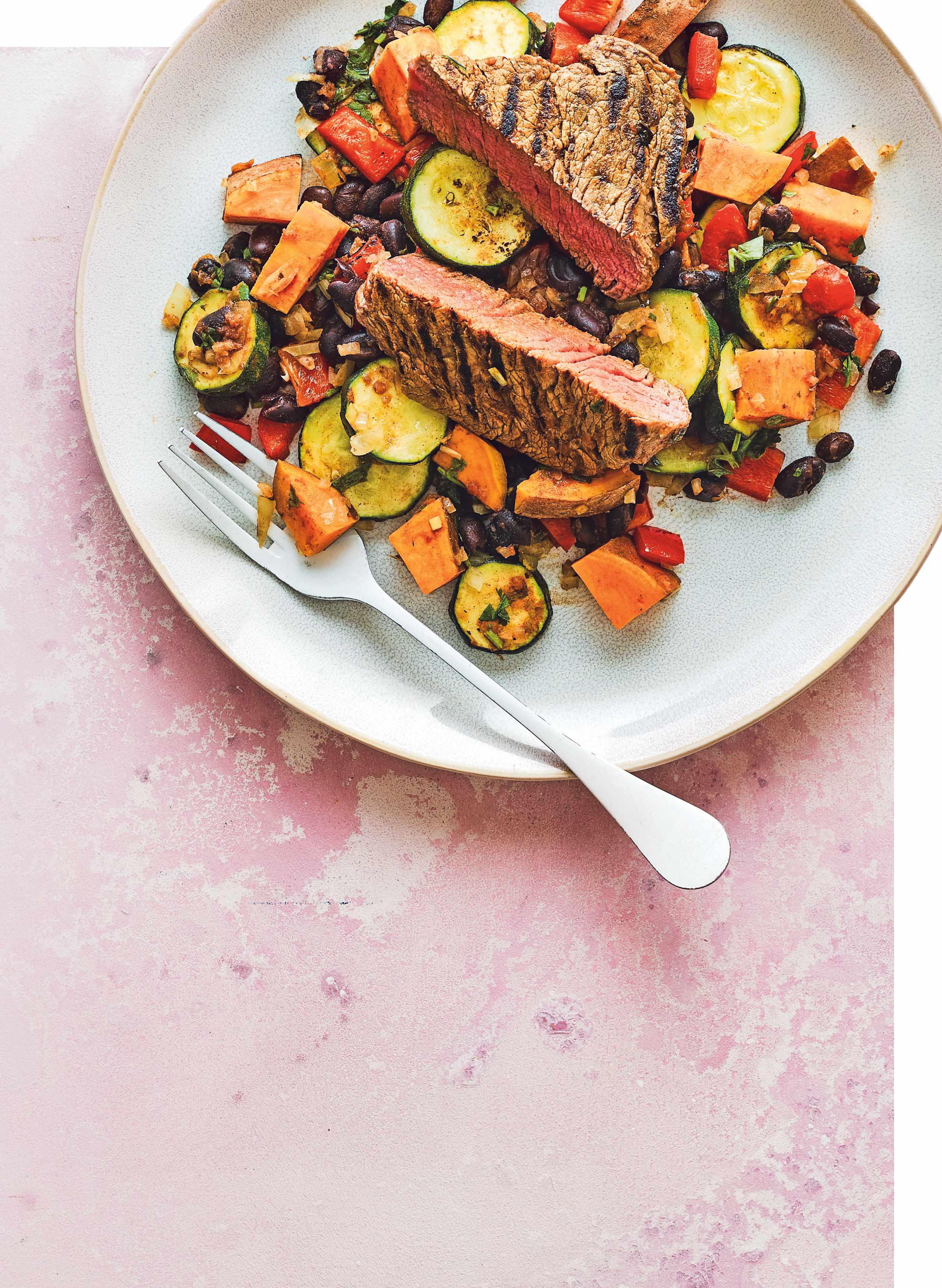
1 red pepper, deseeded and chopped
1 courgette (about 200g), sliced 1 bay leaf (optional)
1 Grate the onion into a bowl until you have 3 tbsp grated onion. Leave the remainder in one piece and set aside. Add 1 tsp of the oil, the lime zest, tamarind, cumin, 2 tbsp coriander, smoked paprika and 1 tsp water. Mix well, then use half the spice paste to coat the steaks all over. Mix the rest with the lime juice, remaining coriander and the beans in a serving bowl.
2 Light the barbecue. Take a large piece of foil and drizzle with the remaining oil. Finely chop the rest of the onion and mix with the sweet
potato, pepper and courgette. Wrap in the foil along with the bay leaf, if using, to make a parcel. Cook on the rack over the coals for about 20 mins, turning several times with tongs until the veg is tender. Tip the contents into the beans and toss well. Barbecue the steaks on both side until cooked to your liking, then serve with the warm salad.
If you don’t want to barbecue the steak, you can grill or pan-fry and roast the parcel in the oven at 200C/180C fan/gas 6 for 25-30 mins, or until the veg is tender.
A medley of colourful veg roasted to perfection, then topped with feta and fragrant herbs. Serve warm or cold, indoors or out – this is summer eating made simple
PER SERVING 198 kcals | fat 12g | saturates 3g | carbs 12g | sugars 11g | fibre 7g | protein 6g | salt 0.33g
SERVES 4 PREP 10 mins COOK 40 mins EASY VEGETARIAN
3 tbsp olive oil
1 aubergine, cut into chunks
2 mixed coloured peppers, such as orange and red, cut into chunks
1 red onion, cut into wedges
2 courgettes, cut into chunks
4 garlic cloves, smashed
3 sprigs of thyme
200g cherry tomatoes
handful of basil leaves
zest of 1 lemon
50g feta, crumbled

1 Heat the oven to 200C/180C Fan/ gas 6. Mix the oil with the aubergine, peppers, red onion, courgette, garlic and thyme in a bowl with sea salt and black pepper. Tip into a large roasting tin then roast for 30 mins. Add the tomatoes to the pan and return to the oven for 10 mins.
2 Squeeze the garlic from their skins, remove the thyme then scatter over the basil, lemon zest and crumbled feta.
Crisped on the outside, fluffy on the inside – these sweet potatoes are loaded with lemony chickpeas and creamy tahini yogurt. Great as a filling veggie main, whether you’re dining al fresco or indoors
PER SERVING 514 kcals | fat 22g | saturates 3g | carbs 61g | sugars 28g | fibre 13g | protein 12g | salt 0.28g
SERVES 4 PREP 20 mins COOK 1 hr EASY VEGETARIAN
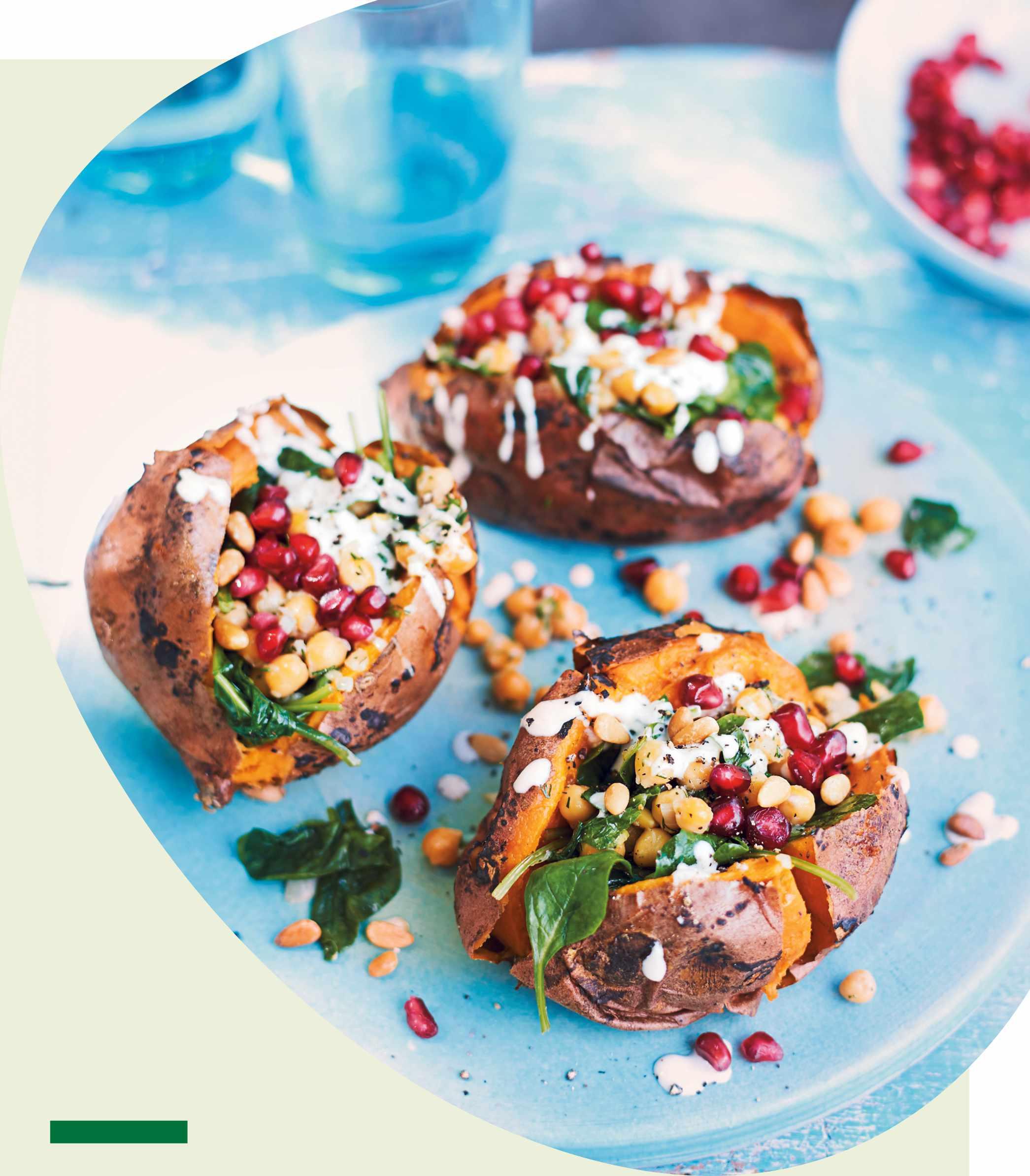
4 medium sweet potatoes
4 tbsp olive oil
1 large garlic clove, crushed
1 banana shallot, finely chopped
400g can chickpeas, drained
75g baby leaf spinach
Dill, finely chopped
Lemon FOR THE TAHINI YOGURT
60g Greek yogurt
2 tbsp tahini
20g pine nuts, toasted 110g pomegranate seeds
1 Wrap each potato in foil and put directly on the hot coals of a barbecue for 35-45 mins, depending on the
size of the potatoes. Insert a skewer into each one to check that they’re cooked. (Alternatively, heat the oven to 200C/180C fan/gas 6 and put the foilwrapped potatoes on a large baking sheet. Bake in the oven for 45 mins1 hr or until the centre is soft. Once cooked, put under a hot grill for 3 mins until the skin is blackened and crispy.)
2 Meanwhile, heat 1 tbsp olive oil in a large frying pan over a medium heat. Add the garlic and shallot and fry for 8-10 mins or until softened, then stir the chickpeas into the mixture. Gently warm through for 1 min or so, then add the spinach and leave to wilt. Add the dill.
3 Whisk together the lemon juice, zest and remaining olive oil in a small bowl and stir into the chickpea mixture, season. Gently mash with a potato masher until the chickpeas are slightly crushed.
4 Mix the Greek yogurt and tahini in another small bowl, and season to taste with salt.
5 Split the potatoes open lengthways. Fill with the bean mixture, spoon over the tahini yogurt and top with the pine nuts and pomegranate seeds.
Meet Helen Minhinett, a creative 56-year-old from Plymouth, who lives with her husband, four sons, and two Labradors, Bentley and Hudson. A proud nanny to her grandchildren who until recently worked as a Teaching Assistant, Helen also enjoys drawing, painting, and anything creative. Over the past year, she’s achieved an incredible weight loss of 6st 13lbs, transforming her health, mobility, and overall well-being.
Helen’s journey began at one of the toughest moments in her life. Living with fibromyalgia, arthritis, asthma, and hypertension, her health had deteriorated drastically. “My mobility was non-existent, and the fatigue was relentless, resulting in me having to resign from a job I loved as a teaching assistant,” she recalls. “I’d reduced my hours by half when my fibromyalgia made it impossible to keep working full-time hours, eventually preventing me from working entirely. It was a decision which wasn’t taken lightly
and which led to my feeling of self-worth being non-existent. I had piled on the weight due to a lack of mobility and depression.”

Weight before (March 2024): 16st 6lbs
Weight now (April 2025): 9st 7lbs
Weight lost: 6st 13lbs
A visit from her friend Donna, who’d lost an incredible 5st using Nutracheck, became Helen’s turning point. “Donna encouraged me to join a group – ‘Weight Loss & Healthy Living With Jane’ – where the leader is an ambassador for Nutracheck. Donna kindly offered to collect me and take me home to enable me to attend each week,” Helen says. “I knew I needed to do something, but I was very anxious as my legs would give out randomly, and I’d had lots of falls and bumps where I’d lose my balance, all thanks to fibromyalgia. Fibromyalgia had taken everything away from me, so I decided enough was enough.”
Since starting her Nutracheck journey
in March 2024 at 16st 6lbs, Helen reached her goal weight of 9st 7lbs exactly one year later, averaging a steady loss of 1-2lbs per week. But the scale was just part of her incredible transformation. “I feel so much healthier. Since losing 6st 13lbs, I have been able to reduce my blood pressure medication from 36mg of Candesartan and 4mg Indapamide at the beginning of my weight loss journey in March 2024 to only 4mg Candesartan today. My doctor is confident that very soon, I won’t need medication for my blood pressure at all,” Helen shares. “My asthma was horrendous, and I was relying on my daily brown inhaler, which I topped up repeatedly with my blue one on a regular day-to-day basis. I now only use my inhalers if I have a chest infection, which is once or twice a year. The weight reduction has also eased the pressure on my knees, making my arthritis bearable.”

however, my quality of life has improved tenfold,” she explains. “I discovered cutting out dairy, gluten, sugar, lactose, among others, have helped my fibromyalgia (however, everyone is different). I’m not advising anyone with fibromyalgia should do this, and it’s certainly not a miracle cure, but it’s well worth looking at foods which could be triggers. It’s lifechanging – for the better.”
Joining the Nutracheck community has been vital for Helen. “When I joined the group I wasn’t aware of the friendships I was going to make,” she says warmly. “Friends for life, who, like me, all use the Nutracheck app. They helped me navigate my way around every benefit the Nutracheck app has to offer.”
She credits half of her success to daily habits: “Using the Daily Diary every single day, weighing my food at every meal and exercising every day.” The other half? Mindset. “A positive mindset that is determined to succeed is crucial, as these habits take commitment, and you need to want to do it for your own, personal reasons.”
“It wasn’t easy, but hard work pays off”
Helen’s fibromyalgia symptoms, though still present, have improved considerably through careful dietary adjustments. “I have researched foods that may make fibromyalgia worse, and over time, I'm working out which foods I should avoid. This has proven life-changing. I still have flare-ups and ache daily;
Helen acknowledges patience was her biggest challenge. “The most difficult part of my weight loss journey was accepting that it wasn’t going to happen overnight,” she admits. “This was a lifestyle change where I could continue enjoying all of my favourite foods, as long as I made sure I logged them honestly on the Nutracheck app. It wasn’t going to be easy, but hard work pays off.”
Once Helen gained momentum, however, she was surprised how easy it was to keep it up. “When I began to see results on the scales and in my clothes, it inspired me to keep going.
As time passed and my health started to improve, it made my food choices even easier.”
Helen’s most significant non-scale victories include “lower blood pressure readings combined with positive mental health, which are essential when coping daily with my fibromyalgia.” She adds, “Best of all, I can keep up with my lively grandchildren and walk my dogs without fear of constantly falling or tripping over. This happens far less frequently now.”
Helen even received a special congratulatory note from her GP, Dr Jordan: “It is fantastic – all down to your hard work. Well done!”
Be honest and choose food wisely.
“Don’t miss hidden calories, weigh your food, look for calorie swaps with a lower calorie intake, and remember to fill up with salad, vegetables and fruit. Then, wash it down with plenty of water.”
Moderation is key. “Don’t deprive yourself of anything; moderation is the key to success. Have an easy day worked into your diary and still log and count everything, making sure you have set your diary to the easy day option on your Nutracheck app. This allows for that extra treat without feeling any guilt.”
Weekly weigh-ins.
“Remember to weigh in each week on the app to enable you to see your progress or where you may be going wrong. This is paramount for a good result and encourages you to stay on track.”

When the heat is on, the last thing you want is to be stuck in a hot kitchen. These fresh, nocook recipes make the most of summer’s best ingredients — and they’re ready in a flash. From zesty salads to refreshing soups and fruity snacks, each dish is big on flavour and low on effort
Fresh, punchy and ready in minutes, this no-cook salad packs black beans, sweet pineapple and creamy avocado into a vibrant bowl. High in fibre and full of flavour, it’s perfect for a speedy lunch or light dinner
PER SERVING Calories: 347 | Fat 15g | Saturates 3g | Carbs 32g | Sugars 13g | Fibre 16g | Protein 12g | Salt: 0.04g
SERVES 2 PREP 10 mins NO COOK EASY VEGAN
1 small onion (80g), halved and thinly sliced
1 lime, juiced
1 avocado, peeled, halved, stoned and cut into chunks
1 red pepper, deseeded and thinly sliced 10g coriander, chopped
½–1 red chilli, deseeded and finely chopped (optional)
400g can black beans, drained 120g pineapple, cut into chunks
Extra virgin olive oil, for drizzling (optional)
1 Put the onion into a bowl and pour over the lime juice. Massage together using your fingers to soften. Add the avocado and toss to coat in the lime juice, then add the pepper, coriander and chilli, if using. Toss in the beans and divide between two bowls or lunch boxes.
2 Scatter over the pineapple and drizzle with a little olive oil before serving, if you like. Best served straight away.

Cool, creamy and packed with greens, this no-cook soup makes a refreshing summer lunch. Topped with marinated feta and crunchy seeds, it’s full of bold flavours and ready to chill in just 20 minutes
PER SERVING 394 kcals | fat 34g | saturates 9g | carbs 8g | sugars 6g | fibre 6g | protein 11g | salt 0.6g
SERVES 4 PREP 20 mins plus 1 hr chilling NO COOK EASY VEGETARIAN
70g vegetarian feta, crumbled
3 tbsp olive oil
1 tsp coriander seeds, crushed
1 large red chilli, deseeded and finely chopped
1 lemon, zested and juiced
200g baby spinach
2 large ripe avocados, stoned and cubed
1 large cucumber, chopped
1 small garlic clove, crushed
250g natural yogurt
small bunch basil
2 tbsp toasted mixed seeds, to serve
1 Put the feta in a bowl and pour over the olive oil, coriander seeds, chilli and lemon zest. Set aside.
2 Tip the remaining ingredients (except the seeds) into a food processor and blitz until smooth. Season. Add 50-100ml cold water and blitz again to loosen. Chill for up to 1 hr.
3 Pour into four bowls and top with the feta, marinating liquid and seeds.
Light, fresh and full of zing, this easy noodle salad pairs juicy mango with shredded chicken and a punchy lime dressing. Quick to prep and no cooking needed, it’s perfect for a speedy lunch or warm-weather dinner
PER SERVING 424 kcals | fat 9g | saturates 2g | carbs 56g | sugars 17g | fibre 4g | protein 27g | salt 1.2g
SERVES 4 PREP 15 mins NO COOK EASY
200g vermicelli rice noodles
(check it’s gluten-free, if needed)
2 limes, juiced, plus wedges to serve (optional)
1 tbsp fish sauce
1 tbsp honey, plus 1 tsp
1 tbsp toasted sesame oil
320g leftover roast chicken, shredded
2 ripe mangoes, stoned, peeled and cut into thin slices
20g coriander, roughly chopped
2 red chillies, seeds removed and thinly sliced
1 Put the noodles in a heatproof bowl, cover with boiling water and leave for 15 mins to soften. Meanwhile, combine the lime juice, fish sauce, honey and sesame oil in a small bowl and whisk together.
2 Drain and rinse the noodles briefly under cold water. Drain again and tip into a large bowl along with the remaining ingredients, except the lime wedges. Pour over the dressing and toss together with seasoning to taste. Divide between four plates and serve with the lime wedges on the side, if you like.
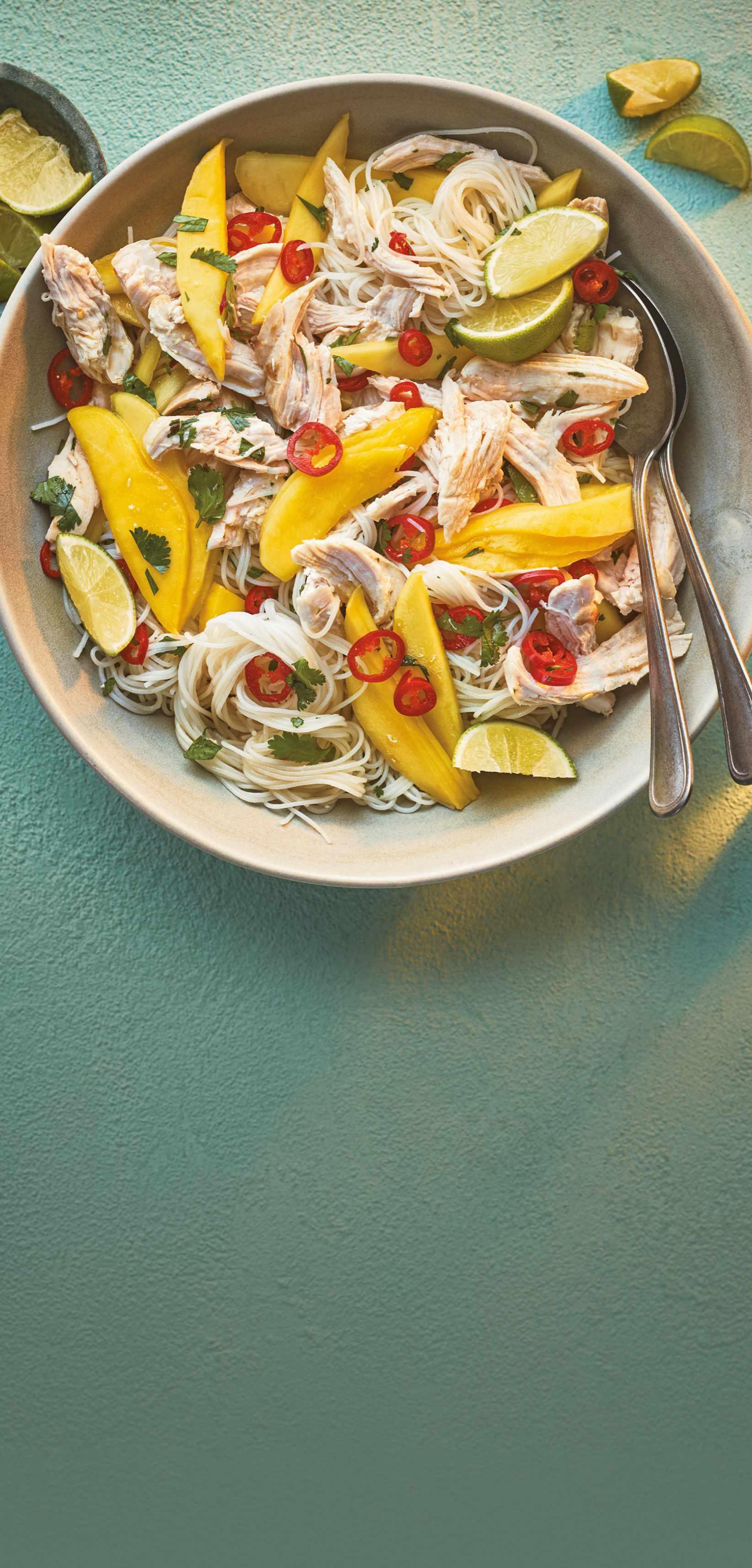
Light, colourful and fun to make, these fresh fruit rolls are perfect for picnics or summer snacking. At just 84 calories per serving, they’re a naturally sweet, no-cook treat paired with a tangy berry coulis for dipping
PER SERVING 84 kcals | fat 1g | saturates 0.2g | carbs 17g | sugars 15g | fibre 2g | protein 1g | salt 0.04g
SERVES 8 PREP 15 mins NO COOK EASY VEGAN
2 kiwi fruits
½ small pineapple
1 small mango
75g blueberries 8 rice paper wrappers
FOR THE COULIS
250g frozen mixed berries, defrosted
3 tbsp honey, maple syrup or other sweetener
1 For the coulis, blitz the berries and honey in a food processor (or in a jug using a hand blender) until very smooth. Add a few tablespoons of water if needed to loosen.
2 Prepare all the fruit by peeling, pitting or coring, as required. Thinly slice a few pieces of each fruit to decorate. Roughly chop the rest.
3 Soften the rice paper rolls by dunking into a wide, shallow bowl of water for a few seconds. Transfer to a work surface, then arrange a layer of fruit slices down the middle (this will be the visible decoration when rolled up). Spoon over some of the chopped fruit, then fold the rice paper wrap in at the sides before rolling up. The rice paper will stick to itself to seal. Keep chilled in a cool box or with an ice pack if travelling to a picnic, then serve with the coulis for dunking.
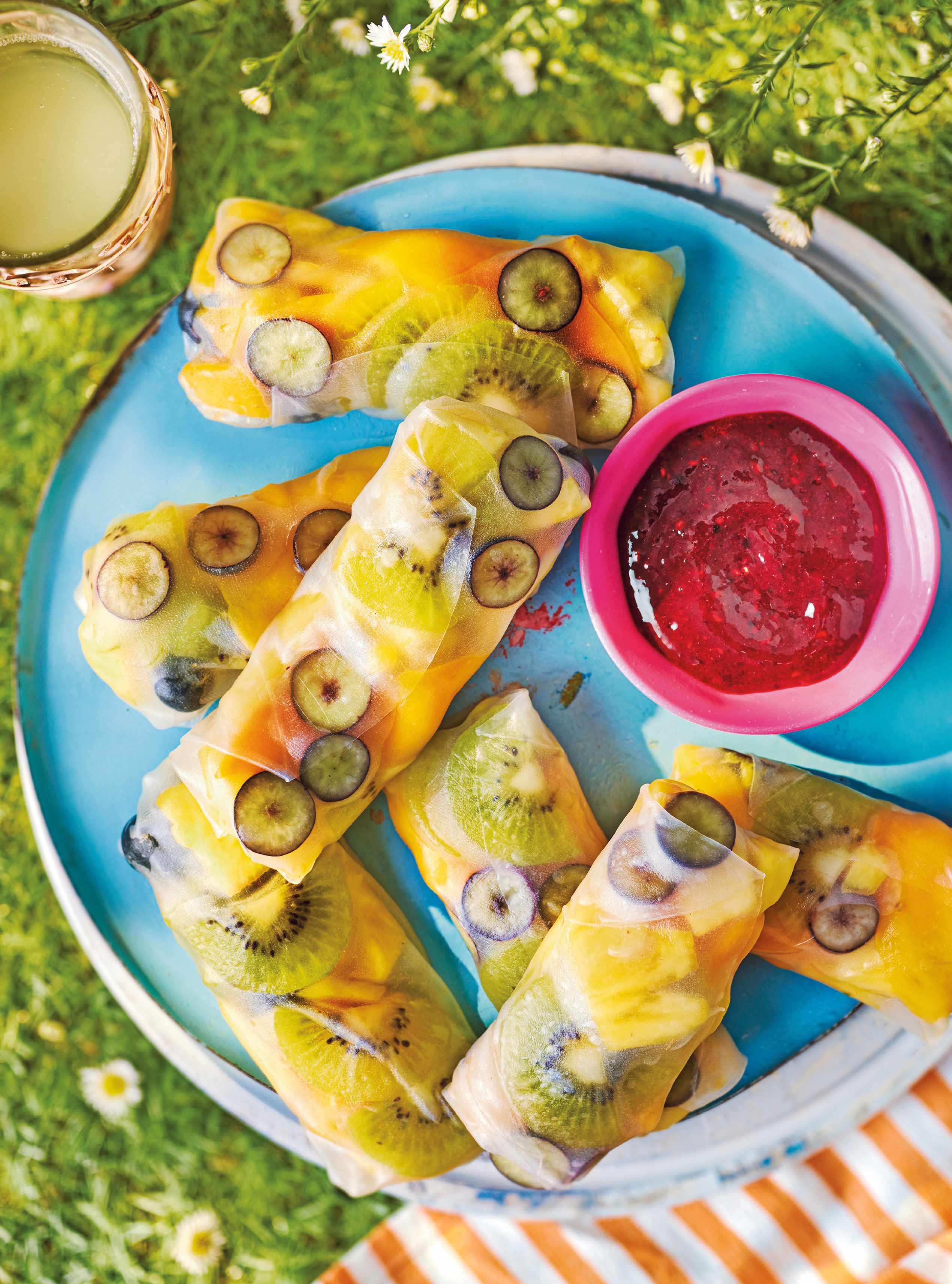
Nutritionist Beth shares her top tips for staying on track while you’re on holiday
QDo I have to track every meal whilst away to reach my goals?
Not necessarily! Tracking can help with accountability and balancing out your choices – but your approach doesn’t have to be all or nothing. If logging everything feels a bit much while you’re out of routine, it may be helpful to try a more relaxed method – perhaps just track your main meals, or focus on drinks and snacks, which can often sneak up on us. Even loosely noting down what you’re eating can help you stay aware of your food consumption. The most important thing is to find a level of tracking that helps you feel in control, while still allowing you to fully enjoy your time away.

QHow do I reduce my drinking calories whilst on holiday?
Enjoying a few drinks while on holiday can be part of the fun, but those calories can sneak up on you quicker than you might think. That said, a few simple swaps can make a big difference. A good approach is alternating your alcoholic drinks with water to stay hydrated and reduce your calorie and alcohol intake. Lighter choices like spritzers, slimline mixers, spirits paired with a low-calorie mixer, or non-alcoholic wines and beers, are great options too. You can still enjoy a drink or two without overdoing it – it’s all about pacing yourself and making conscious choices.
Q
How do I stop myself from overeating at the all-inclusive buffet?
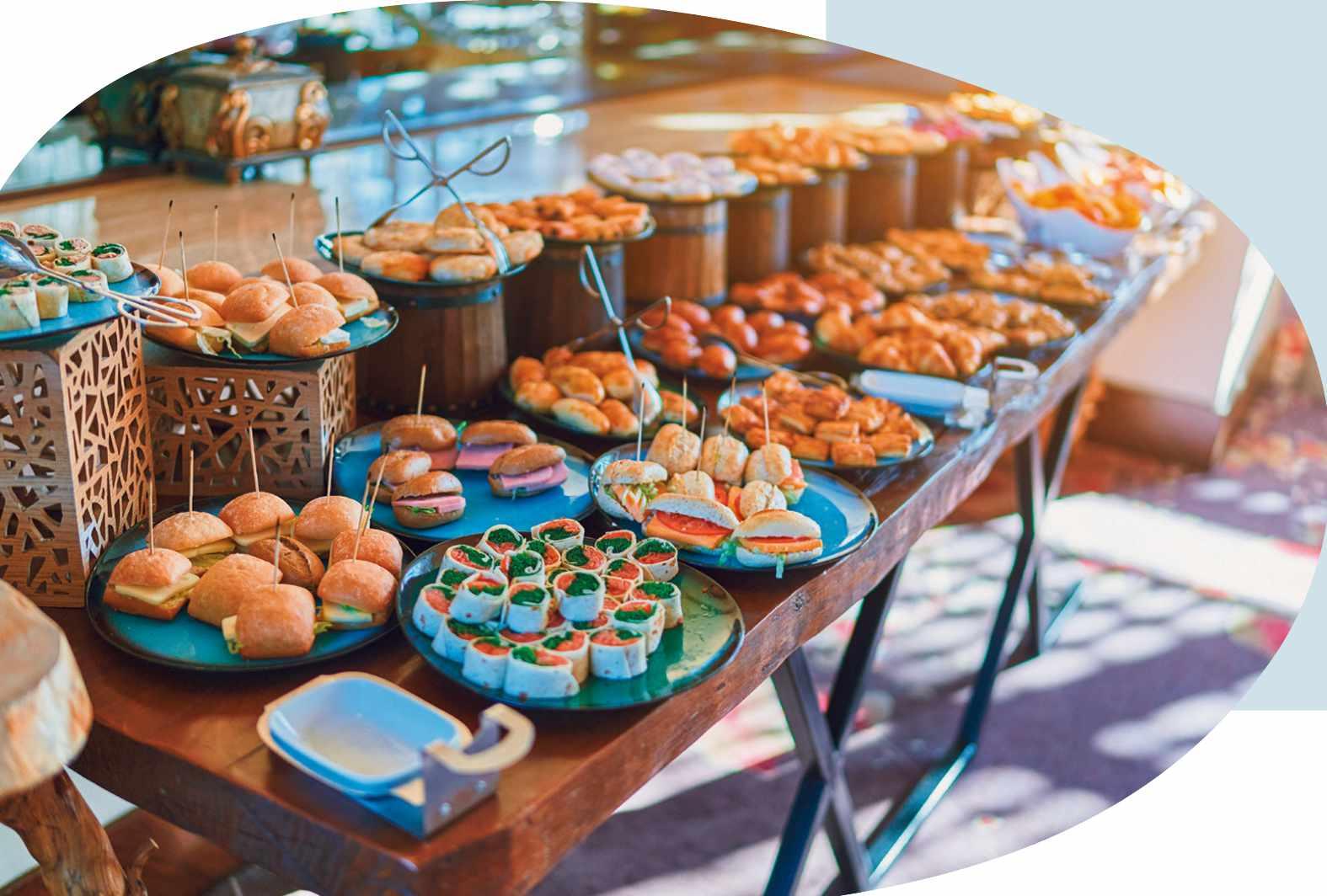
When you are aiming to eat well whilst on holiday, buffets can sometimes feel overwhelming – but they can actually be a great opportunity to enjoy a variety of foods mindfully. Start by scanning the whole buffet before filling your plate, then pick a few things you’re genuinely excited to eat. A good rule of thumb is to fill half your plate with salad or vegetables, a quarter with lean protein, and a quarter with carbs. Try to eat slowly and check in with your hunger – it’s okay to go back for more if you’re still hungry. But taking your time helps you avoid that uncomfortably full feeling. And if there’s a dessert table? Pick a small portion of something you’ll enjoy –you’re on holiday after all!

QShould I be avoiding all sweet treats whilst I’m away to stay on track?
Not at all! The occasional ice cream or slice of cake isn’t going to derail your progress, in fact, being too strict can often backfire. The goal is to enjoy less nutrient-dense options without guilt and to find a healthy balance. One idea is to choose one or two lesshealthy options each day that you’ll really enjoy whilst you’re away, and savour them. You could also balance things out by choosing lighter meals around those moments – for example, opting for a lighter main course if you know you want a pudding after. It’s all about maintaining a positive relationship with both the foods that support and look after your body and the ones that simply bring you joy.
QHow do I avoid the holiday bloat?
Holiday bloating is really common (we’ve all been there!). Changes in routine, more indulgent meals, extra alcohol, and less movement can all play a role. If this is something you struggle with, it may help to focus on staying hydrated, minding your intake of fatty or greasy foods, keeping some fibre in your meals, and moving your body daily (even a 20-minute stroll can aid digestion). Try to eat slowly and be aware of your fullness cues too – avoiding feeling overly full can prevent that heavy, uncomfortable feeling. And don’t forget, a bit of bloating is quite normal too – your body’s just adjusting to a different routine!
QHow should I keep hydrated whilst I’m on holiday?
Staying hydrated is just as important on holiday, if not more so, especially if you’re heading somewhere hot! Increased heat and activity can lead to faster fluid loss, even if you’re lounging poolside. Aim for 6-8 glasses of fluid a day as a minimum, and more if you’re sweating or drinking alcohol. Water is always best, but all non-alcoholic fluids count! Drinks like sparkling water with slices of fruit, herbal teas, or even snacking on hydrating fruits like watermelon will all help to top up your hydration. Carrying a reusable bottle or setting gentle reminders on the app can also be useful to keep you sipping throughout the day without even thinking about it.


APP TIP
You can set reminders on the Nutracheck app. Here’s how:
Tap the blue ‘Menu’ button > ‘Reminders’ > ‘Water’
move of the month

1 2 3 4
Lie flat on your back with your legs extended and arms resting comfortably at your sides.
Slowly lift both legs together until they form a 90-degree angle with your torso. Keep the movement controlled and smooth.
Carefully lower your legs back down without letting them touch the floor, maintaining tension in your core.
Aim for 10–15 repetitions, completing 2–3 sets, adjusting repetitions as needed based on your fitness level.
Strengthen your core, boost stability, and build lower-body endurance with this effective, equipment-free move 2 1


With over 10 years’ experience in the fitness industry and a background in sport and exercise science, Matt is committed to helping others achieve a balanced, healthy lifestyle. Providing support on exercise and nutrition, ensuring members have the tools needed to reach their goals, while offering practical advice and encouragement every step of the way.
Leg raises effectively target your lower abdominal muscles, building core strength and stability. A stronger core supports better posture and balance, while engaging your hip flexors helps boost lower-body endurance and coordination. Plus, this simple move can be done anywhere –no equipment needed – making it easy to fit into any routine.
To ease pressure on your lower back, perform the movement with slightly bent knees. If you need extra support, place your hands underneath your hips to help maintain proper form and stability. Focus on slow, controlled movements and engage your core throughout to get the most out of each rep. If it feels too challenging, start with fewer reps and build up gradually.
• Keep your lower back pressed gently against the floor to protect your spine and reduce strain.
• Engage your core muscles throughout the movement for better control and effectiveness.
• Breathe steadily – inhale slowly as you lower your legs, and exhale as you lift them back up.
• Don’t let your lower back arch away from the floor – this can cause unnecessary strain.
• Don’t drop your legs too quickly. Slow, controlled movements will help you to engage the muscles safely.

• If you experience discomfort or strain in your lower back, adjust the exercise or consider an alternative move to help you build up the required strength.

Log your water intake with Nutracheck
Keep track of how much water you drink daily – set personalised reminders and hit your hydration goals with ease. Simple logging, big health benefits.
Start your 7-day free trial today
Packed with fresh flavours, nourishing ingredients and a sunny feel, this easy three-day meal plan brings the best of the Mediterranean diet to your table. Every recipe is calorie-counted, between 250-500 calories per serving, to help you stay on track without feeling restricted.
You’ll enjoy plenty of colourful vegetables, heart-healthy fats, lean proteins and fibre-rich grains – all hallmarks of the Mediterranean way of eating. Plus, with each day adding up to under 1500 calories, you can mix, match and adjust to suit your goals.
If you need slightly more calories, reach for Mediterraneanfriendly snacks like a handful of olives, a few almonds, a small portion of hummus with crudités, or a slice of melon. Just don’t forget to log any extras in the Nutracheck app!
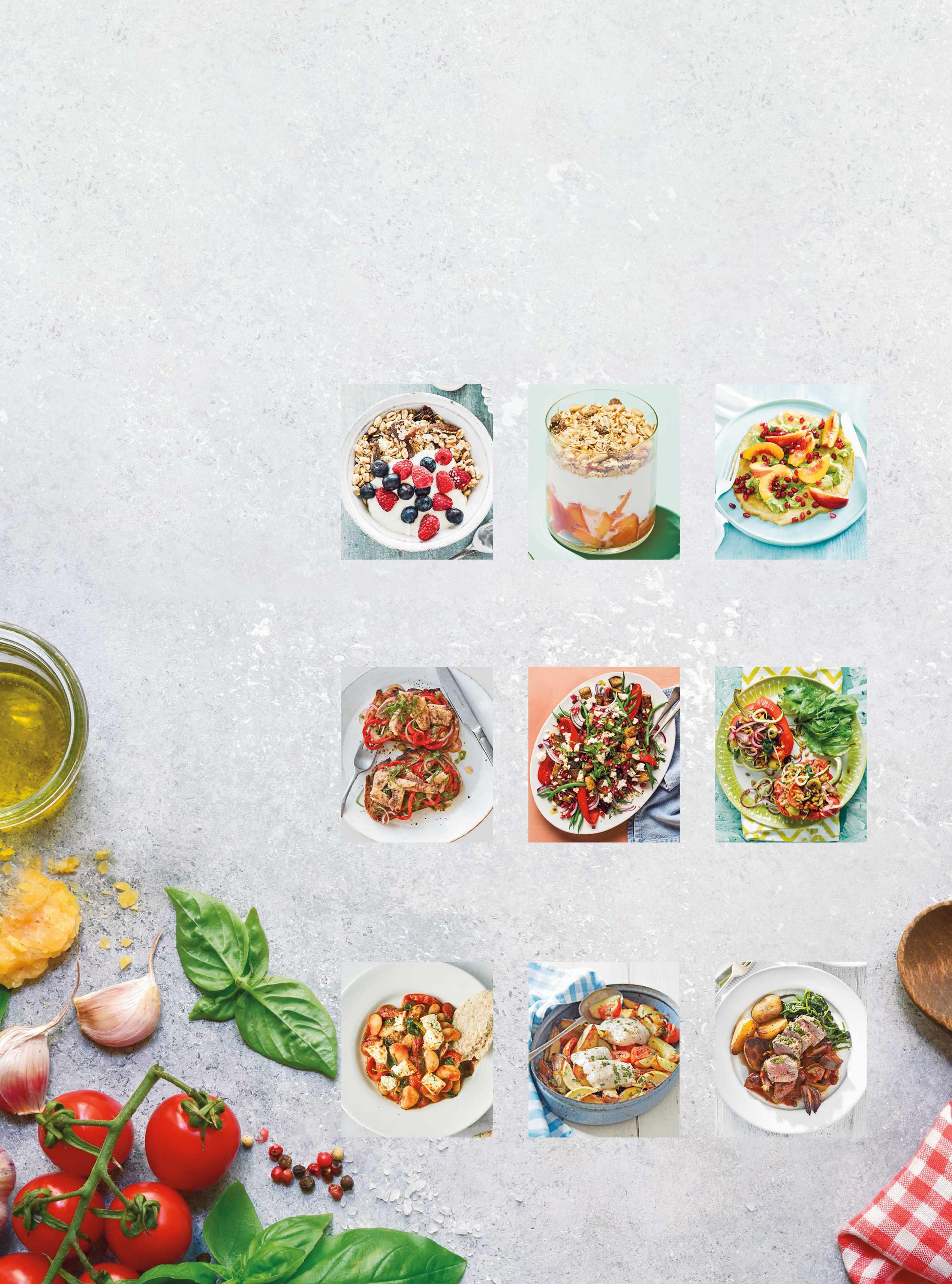
Start your day the Mediterranean way with fresh, nourishing breakfasts

Wholesome oats, crunchy pecans and sweet dates come together for a fibre-rich breakfast full of Mediterranean flavour
PER SERVING 478 kcals | fat 23g
| saturates 5g | carbs 46g | sugars
24g | fibre 7g | protein 17g | salt 0.3g
SERVES 4 PREP 5 mins
COOK 2 mins EASY
VEGETARIAN
100g traditional oats
12 pecan nuts, broken into pieces
2 tbsp sunflower seeds
6 pitted medjool dates, snipped into pieces
25g high-fibre puffed wheat
4 x pots bio yogurt
300g mixed berries, such as raspberries, strawberries and blueberries
generous sprinkling of ground cinnamon (optional)
1 Tip the oats into a frying pan and heat gently, stirring frequently until they are just starting to toast. Add the pecans and seeds to warm briefly, then tip into a large bowl and toss so they cool quickly.
2 Add the dates and puffed wheat, mix well until thoroughly combined, then serve topped with the yogurt and fruit, and a sprinkling of cinnamon, if you like.
Layered with soft peaches, zingy orange and spiced oats, these yogurt pots are a refreshing and satisfying start to your morning
PER POT 357 kcals | fat 11g | saturates 3g | carbs 47g | sugars 27g | fibre 5g | protein 14g | salt 0.3g
MAKES 4 PREP 10 mins
COOK 7 mins EASY VEGETARIAN
4 peaches or nectarines, stoned and diced
1 orange, juiced and zested
120g porridge oats
25g pine nuts
½ tsp ground ginger
1 tsp ground cinnamon
2 tbsp sultanas
4 x 150ml pots bio yogurt
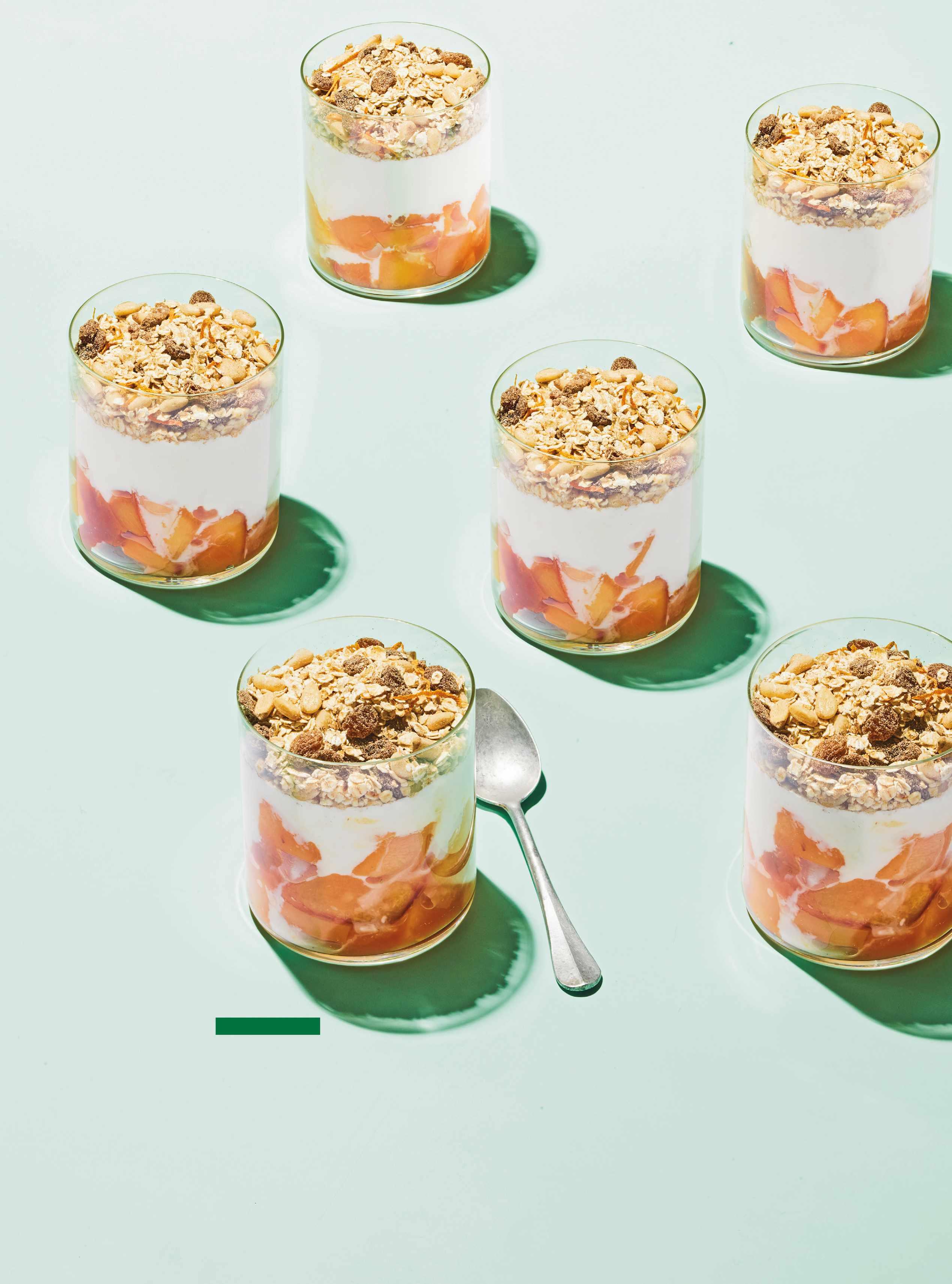
1 Put the peaches and orange juice in a small pan. Put the lid on and cook gently for 3-5 mins, depending on their ripeness, until softened. Set aside to cool.
2 Tip the oats and pine nuts into a pan and heat gently, stirring frequently until they’re just starting to toast. Turn off the heat and add the spices, zest and sultanas.
3 Spoon the peaches and juices into four tumblers and top with the yogurt. Cover and chill until needed. Keep the oat mixture in an airtight container. When ready to serve, top the pots with the oat mixture.
Soft almond crêpes piled high with creamy avocado, juicy nectarines and bursts of pomegranate. A fresh, flavourpacked way to start your day
PER SERVING 457 kcals | fat 34g | saturates 5g | carbs 18g | sugars 16g | fibre 7g | protein 16g | salt 0.2g
SERVES 2 PREP 10 mins COOK 5 mins EASY VEGETARIAN

2 large eggs
3 tbsp ground almonds
2 tsp rapeseed oil
1 avocado, halved, stoned and flesh lightly crushed
2 ripe nectarines, stoned and sliced seeds from ½ pomegranate ½ lime, cut into 2 wedges, for squeezing over
1 Beat one egg and 1 ½ tbsp of the almonds in a small bowl with 1 tbsp water. Heat 1 tsp oil in a large non-
stick frying pan over a medium heat and pour in the egg mixture, swirling the pan to evenly cover the base. Cook until the mixture sets and turns golden on the underside, about 2 mins. (There is no need to flip it over.) Turn it out onto a plate and make another one with 1 tbsp water, the remaining egg, oil and almonds.
2 Top each crêpe with the avocado, nectarines and pomegranate, and squeeze over the lime at the table.
Bright, satisfying lunches inspired by the flavours of the Mediterranean

Grilled peppers, olives and capers bring bold Mediterranean flavours to this easy sardine-topped toast – perfect for a quick, filling lunch
PER SERVING 513 kcals | fat 25g | saturates 5g | carbs 38g | sugars 5g | fibre 6g | protein 30g | salt 4g
SERVES 1 PREP 10 mins COOK 2 mins EASY
1 tbsp extra virgin olive oil
½ tbsp red wine vinegar
1 large red pepper from a jar, thinly sliced
1 small shallot, thinly sliced
½ tbsp capers
½ small garlic clove, finely sliced
½ small bunch basil, shredded
2 slices wholemeal bread
120g can sardines in olive oil, drained
1 Whisk the oil and vinegar in a bowl. Mix in the pepper, shallot, capers and garlic. Toss with half the basil and season to taste.
2 Toast the bread until crisp and golden. Top with the peperonata and large chunks of the sardines. Finish with the remaining basil and a good grind of black pepper.
A vibrant salad with roasted aubergines, sweet peppers and a punchy pomegranate dressing, finished with creamy crumbles of feta
PER SERVING 258 kcals | fat 21g | saturates 5g | carbs 12g | sugars 11g | fibre 0g | protein 6g | salt 0.94g
SERVES 8 PREP 10 mins
COOK 30 mins EASY VEGETARIAN
2 red peppers
3 medium aubergines, cut into chunks, or 15 small, halved
6 tbsp extra-virgin olive oil
1 tsp cinnamon
200g green bean, blanched (use frozen if you can)
1 small red onion, sliced into half moons
200g feta cheese, drained and crumbled seeds of 1 pomegranate handful parsley, roughly chopped
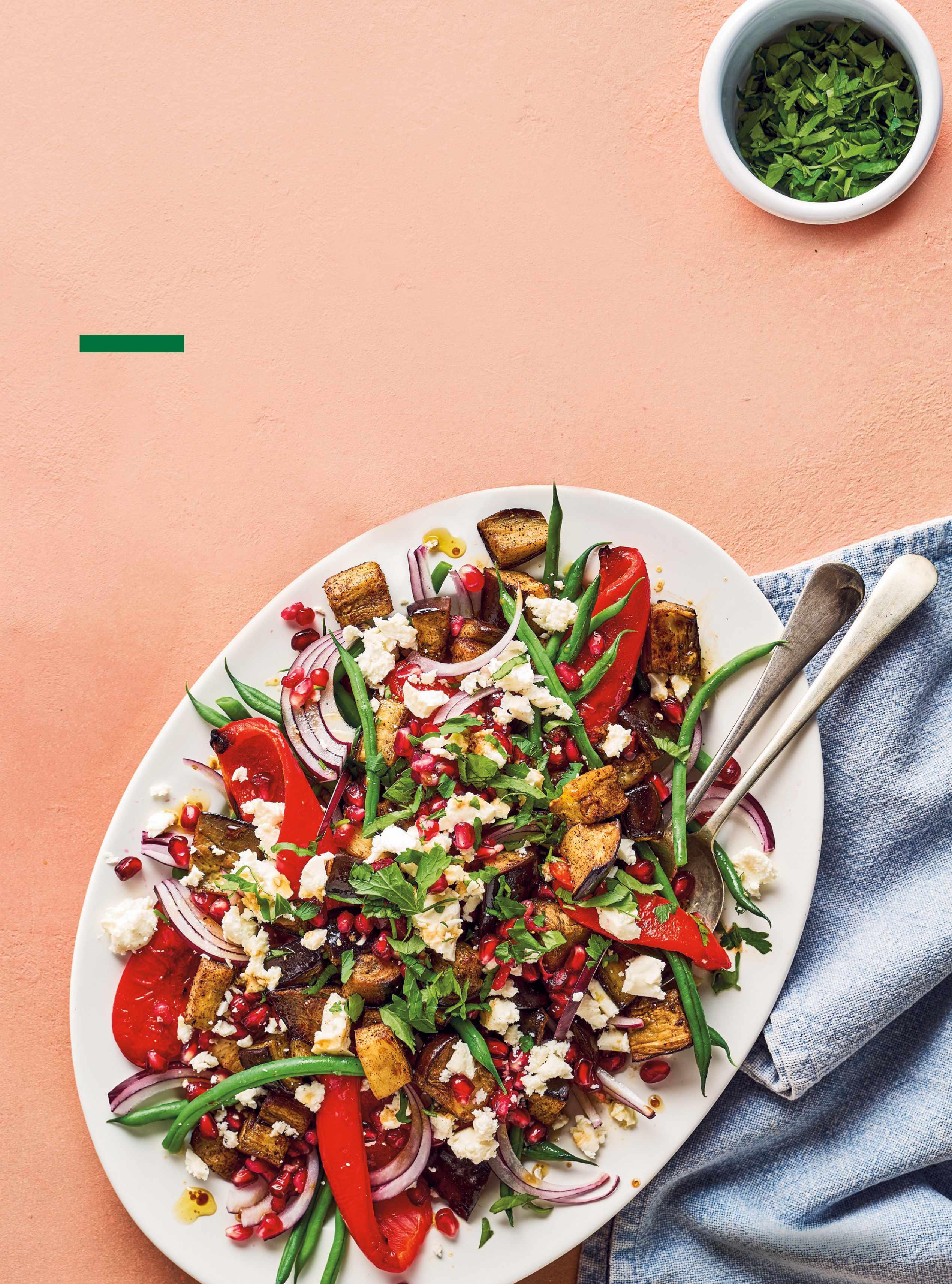
FOR THE DRESSING
1 small garlic clove, crushed
1 tbsp lemon juice
2 tbsp pomegranate molasses
5 tbsp extra-virgin olive oil
1 Heat oven to 200C/fan 180C/gas 6 Heat the grill to its highest setting. Cut the peppers into quarters, then place them, skin-side up, on a baking sheet. Grill until blackened. Place in a plastic bag, seal, then leave for 5 mins. When cool enough to handle, scrape skins off, discard, then set the peppers aside.
2 Place the aubergines on a baking tray, drizzle with olive oil and
cinnamon, then season with salt and pepper. Roast until golden and softened – about 25 mins.
3 Meanwhile, combine all the dressing ingredients and mix well. To serve, place the aubergines, green beans, onion and peppers on a large serving plate. Scatter with the feta and pomegranate seeds. Pour the dressing over, then finish with the parsley.
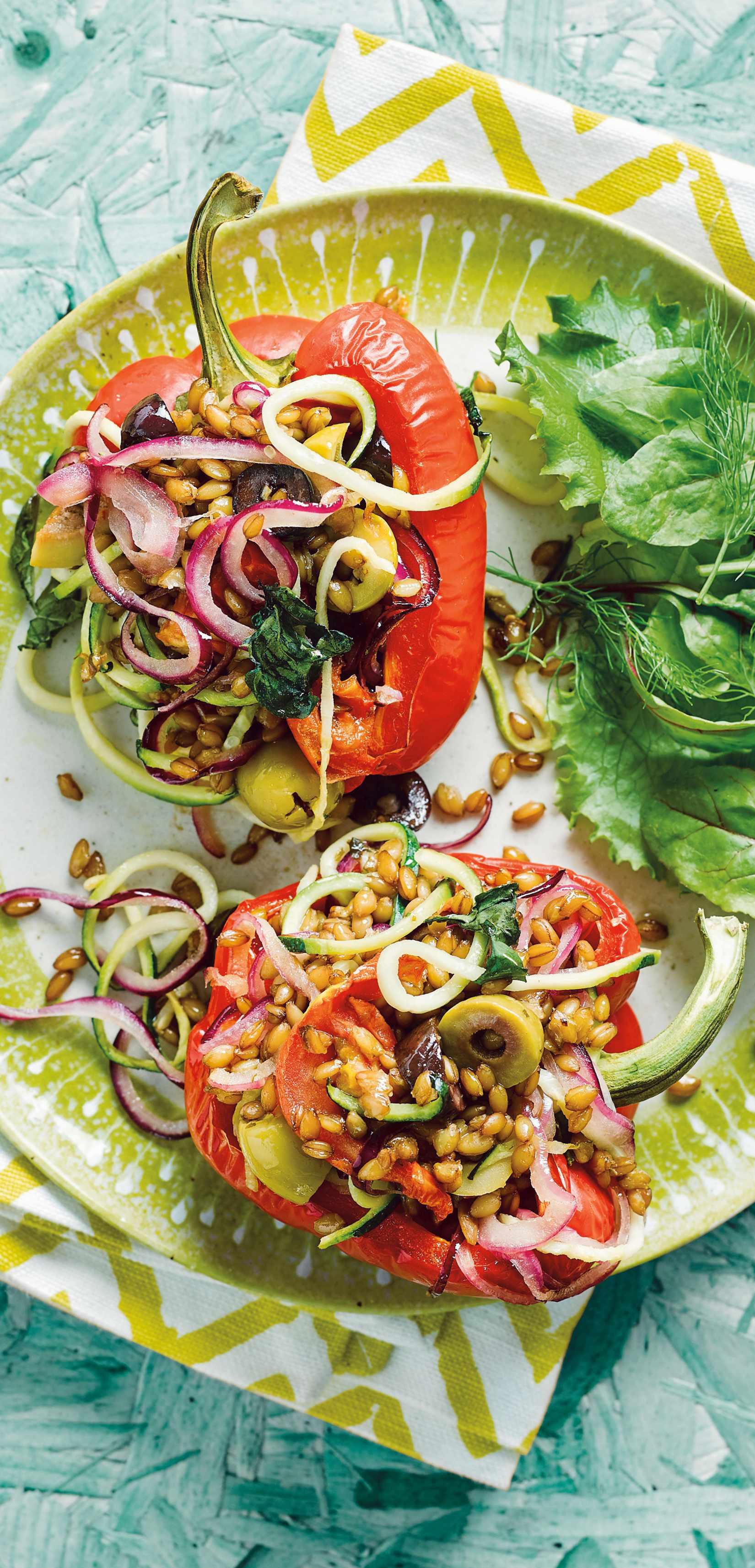
Tender roasted peppers packed with a hearty spelt and vegetable filling, making a simple and satisfying Mediterranean-inspired meal
PER SERVING 345 kcals | fat 11g | saturates 2g | carbs 44g | sugars 22g | fibre 12g | protein 10g | salt 0.8g
SERVES 4 PREP 20 mins
COOK 25 mins EASY VEGETARIAN
4 large red peppers, halved and deseeded (stems left on)
100g fresh sundried tomatoes (sometimes called semidried or sun blush), chopped plus 2 tbsp tomato oil
1 large red onion, ends trimmed and spiralized on the flat blade of the spiralizer
1 large courgette, halved widthways, ends trimmed and spiralized into thin noodles
250g pouch pre-cooked spelt
100g mixed olives, pips removed and chopped
1 small pack of basil, shredded green salad, to serve
1 Heat oven to 200C/180C fan/gas
6. Place the peppers cut-side up on a roasting tray. Drizzle over 1 tbsp of the sundried tomato oil, season with sea salt and black pepper then roast for 20–25 mins until the peppers are tender.
2 Meanwhile, heat the remaining oil in a frying pan over a medium heat. Add the spiralized red onion. Cook for 2–3 mins until softened then transfer to a bowl.
3 Add in the remaining ingredients and some seasoning. Once the peppers are cooked, generously fill them with the spelt mix and return to the oven for 5 mins to heat through. Serve with a green salad.
Wholesome, feel-good dinners packed with Mediterranean goodness

Golden, grilled feta sits on a bed of saucy butter beans and spinach for a simple but seriously satisfying Mediterranean-style dinner
PER SERVING 506 kcals | fat 9g | saturates 4g | carbs 69g | sugars 10g | fibre 18g | protein 28g | salt 1.3g
SERVES 4 PREP 2 mins COOK 18 mins EASY VEGETARIAN
500ml passata
2 x 400g cans butter beans, drained and rinsed
2 garlic cloves, crushed
1 tsp dried oregano, plus a pinch
200g spinach
2 roasted red peppers, sliced
½ lemon, zested and juiced
100g block of feta, cut into chunks
½ tsp olive oil
4 small pittas
1 Put a large ovenproof frying pan over a medium-high heat, and tip in the passata, butter beans, garlic, oregano, spinach and peppers. Stir together and cook for 6-8 mins until the sauce is bubbling and the spinach has wilted. Season, then add the lemon juice.
2 Heat the grill to high. Scatter the feta over the sauce, so it’s still exposed, drizzle with the olive oil and sprinkle over the lemon zest plus a pinch of oregano, then grind over some black pepper. Grill for 5-8 mins until the feta is golden and crisp at the edges.
3 Meanwhile, toast the pittas under the grill or in the toaster, then serve with the beans and feta.
Tender white fish fillets nestled in herby roast veg with lemon and garlic – a fuss-free, Mediterranean-inspired dinner that comes in at under 400 calories
PER SERVING 388 kcals | fat 13g | saturates 2g | carbs 42g | sugars 11g | fibre 6g | protein 23g | salt 0.4g
SERVES 2 PREP 10 mins COOK 50 mins EASY
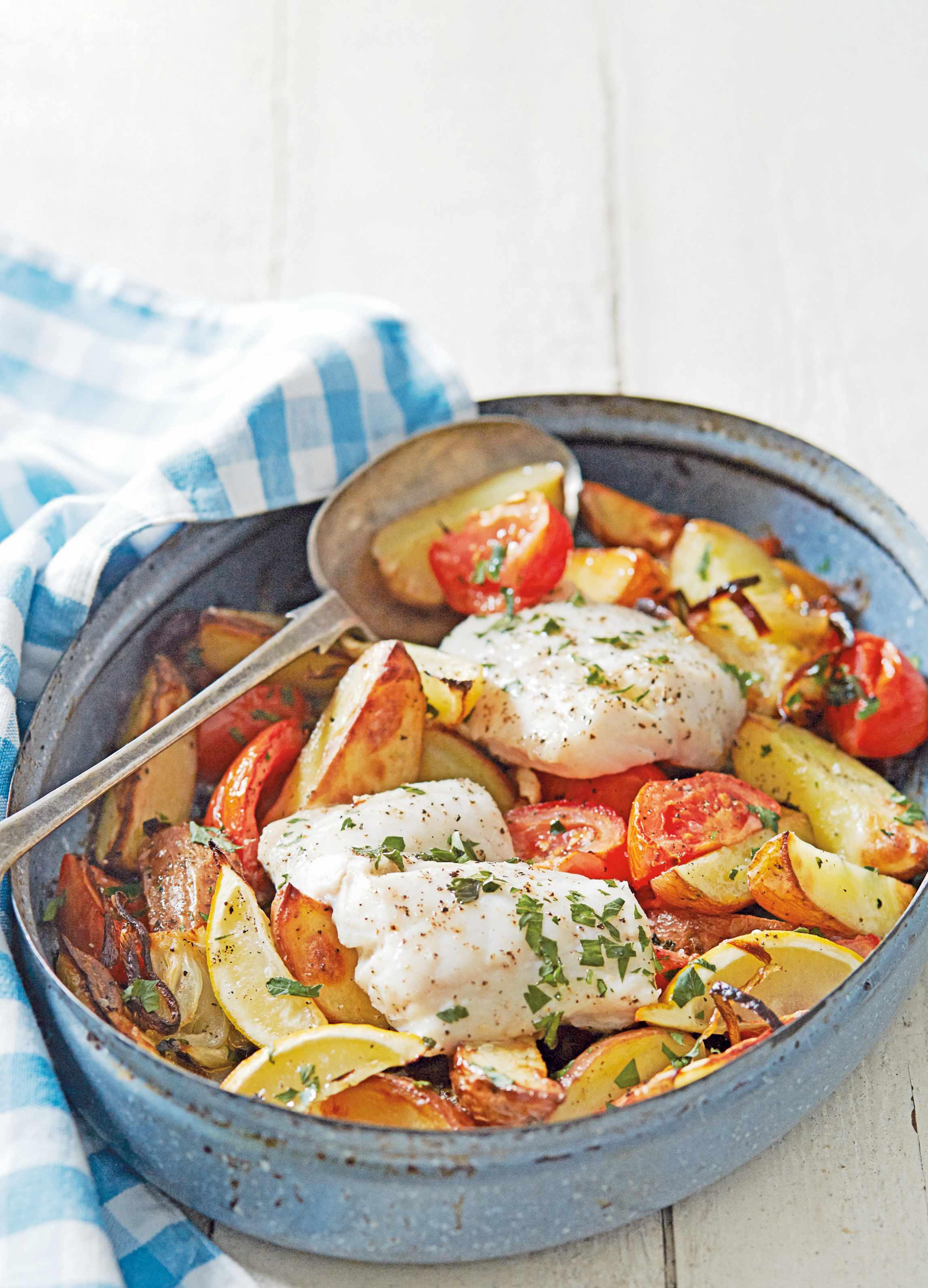
5 small potatoes (about 400g), scrubbed and cut into wedges
1 onion, halved and sliced
2 garlic cloves, roughly chopped
½ tsp dried oregano or 1/2 tbsp chopped fresh oregano
2 tbsp olive oil
½ lemon, cut into wedges
2 large tomatoes, cut into wedges
2 fresh skinless pollock fillets (about 200g)
small handful parsley, roughly chopped
1 Heat oven to 200C/180C fan/gas
6. Tip the potatoes, onion, garlic, oregano and olive oil into a roasting tin, season, then mix together with your hands to coat everything in the oil. Roast for 15 mins, turn everything over and bake for 15 mins more.
2 Add the lemon and tomatoes, and roast for 10 mins, then top with the fish fillets and cook for 10 mins more. Serve with parsley scattered over.
Juicy lamb fillet paired with a rich aubergine caponata — a classic Mediterranean-style dish that’s big on flavour and easy to cook
PER SERVING 483 kcals | fat 17g | saturates 5g | carbs 40g | sugars 24g | fibre 17g | protein 34g | salt 1.4g
SERVES 2 PREP 10 mins
COOK 25 mins EASY
FOR THE CAPONATA
3 garlic cloves
2 tsp rapeseed oil
1 red onion, cut into wedges
1 aubergine, sliced and quartered
500g carton passata
1 green pepper, quartered, deseeded and sliced
6 pitted Kalamata olives, halved and rinsed
2 tsp capers, rinsed
1 tsp chopped rosemary
1 tsp balsamic vinegar
FOR THE LAMB & POTATOES
4 baby new potatoes, halved
1 tsp chopped rosemary
1 tsp rapeseed oil
250g lean lamb loin fillet, all visible fat removed
240g bag baby spinach
finely chopped parsley (optional)
1 Slice 2 of the garlic cloves for the caponata, finely grate the other for the lamb and set aside. Heat the oil for the caponata in a wide pan, add the onion and fry for 5 mins to soften. Tip in the aubergine and cook, stirring, for 5 mins more. Add the passata
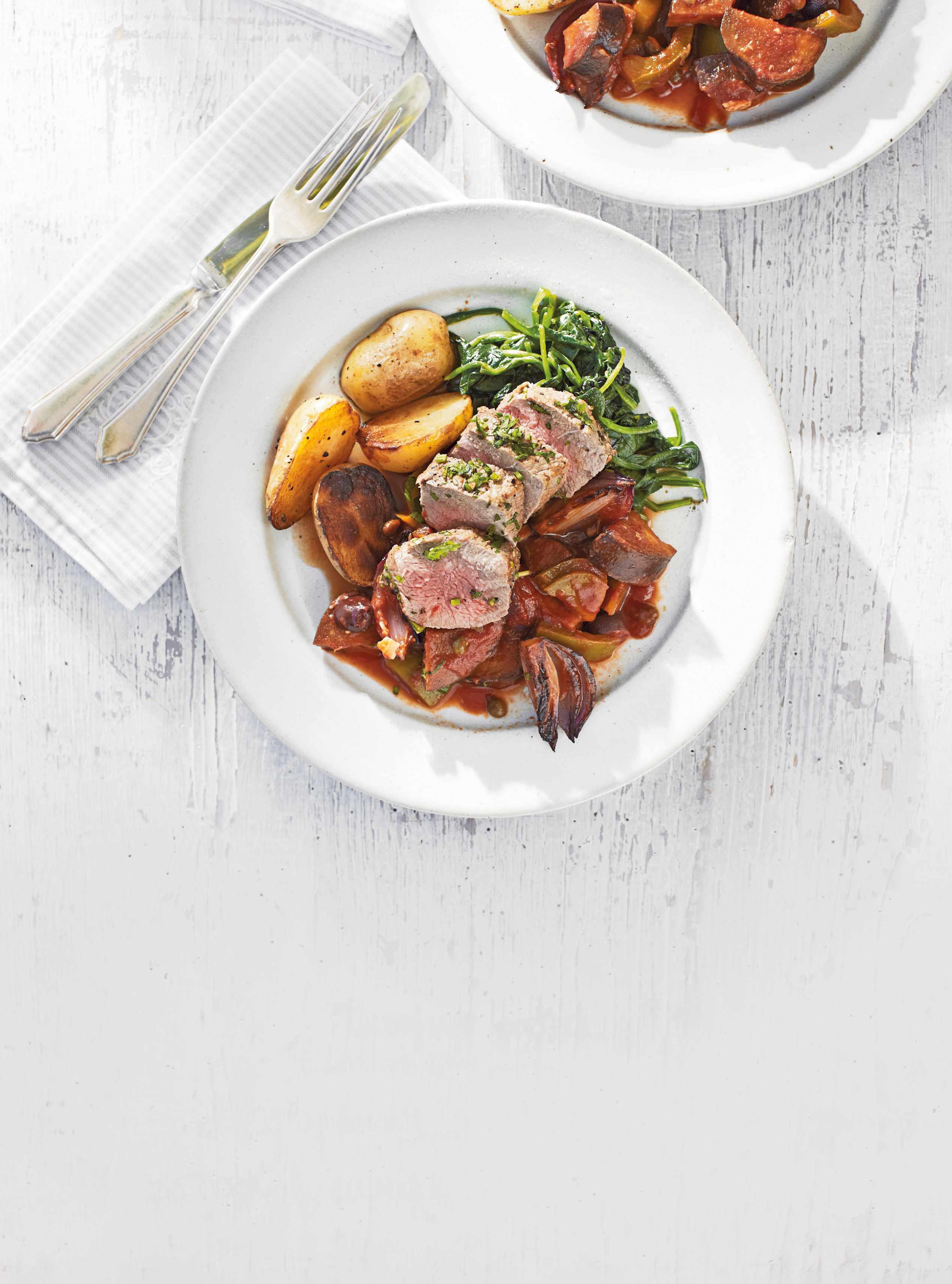
and pepper with the olives, capers, rosemary and balsamic vinegar, then cover and cook for 15 mins, stirring frequently.
2 Meanwhile, heat the oven to 190C/170C fan/gas 5. Boil the potatoes for 10 mins, then drain. Mix the grated garlic with the rosemary and some black pepper, then rub all over the lamb. Toss the potatoes in the oil with some more black pepper, place in a small roasting tin with the lamb and roast for 15-20 mins. Meanwhile, wilt the spinach in the microwave or in a pan, and squeeze to drain any excess liquid.
3 Stir the garlic into the caponata and serve with the lamb, either whole or sliced, rolled in parsley if you like, with the potatoes and spinach.
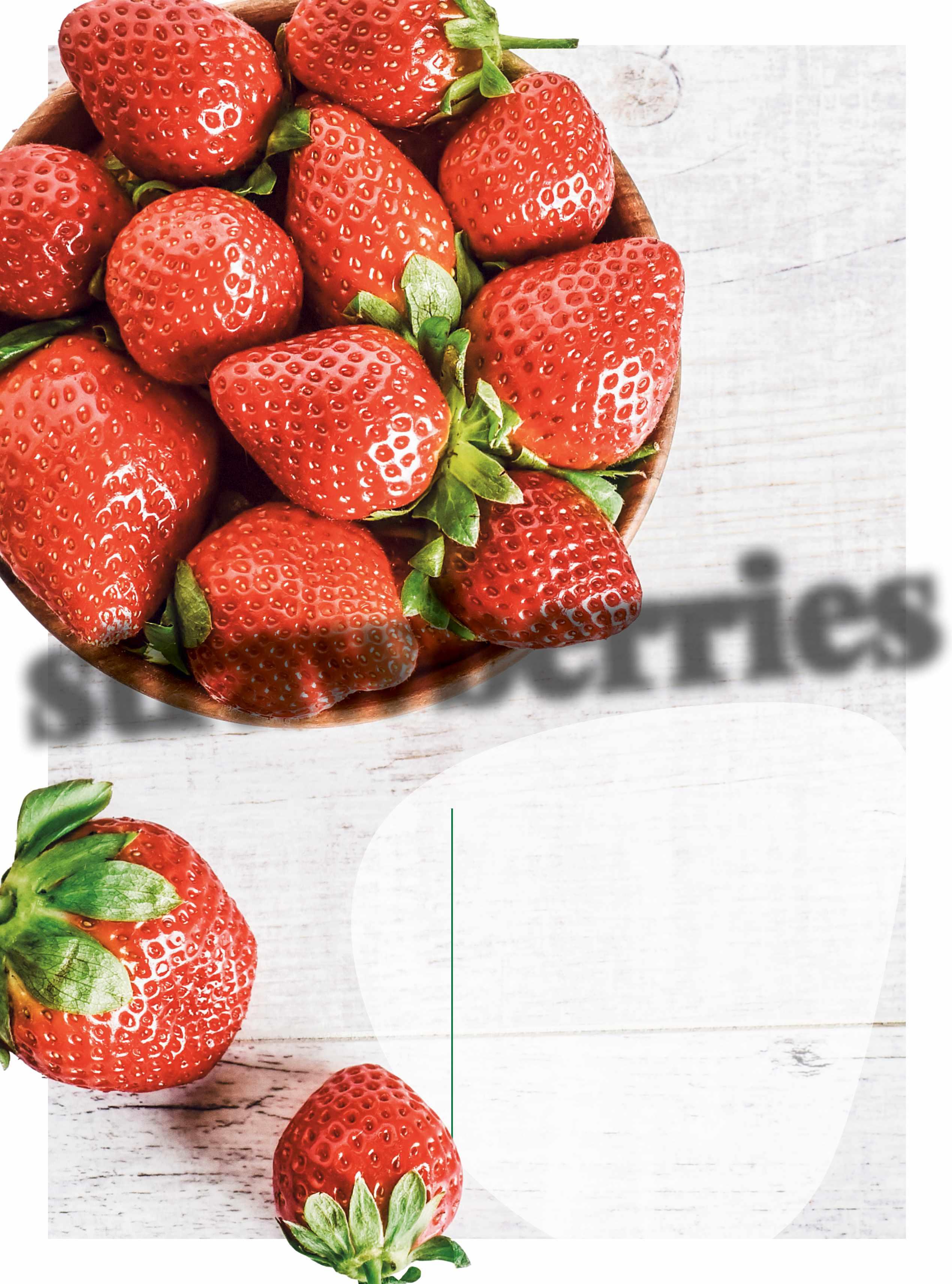
Sweet, juicy and full of summer goodness – here’s why strawberries deserve centre court on your plate












ha ís in season?

Each season, we spotlight a fruit or veg at its very best. This time, it’s the turn of the nation’s summer sweetheart: strawberries. Whether you’re picking them fresh or picking them up from the supermarket, these ruby-red berries are bursting with flavour – and they’re right at home in everything from salads to ices.
Why should I be eating strawberries?
Naturally sweet yet surprisingly low in calories, strawberries are a brilliant way to satisfy your sweet tooth while getting a boost of nutrition. They’re rich in vitamin C (great for supporting the function of our immune systems), plus they’re a source of fibre, which helps keep digestion ticking over.
And let’s not forget – strawberries are a British summer icon. With their famously short season, they’ve long been a staple at garden parties, picnics, and of course, Wimbledon. In fact, around 38.4 tons of strawberries are eaten every year at the tournament, usually with a dollop of cream – but we’ve got some lighter, just-as-delicious options to enjoy while watching the tennis.
Try these fresh, flavour-packed ideas next time you fancy a summer treat – they’re perfect whether you’re hosting a get-together or catching the finals from your sofa

A colourful salad that’s anything but ordinary – think sweet berries, ripe tomatoes and peppery greens brought together with a tangy-sweet pink peppercorn dressing
PER SERVING 128 kcals | fat 9g | saturates 1g | carbs 8g | sugars 8g | fibre 5g | protein 2g | salt 0.04g
SERVES 4 PREP 10 mins COOK 2 mins EASY VEGETARIAN
300g strawberries
250g mixed tomatoes
100g watercress
FOR THE DRESSING
1 tbsp pink peppercorns
2 strawberries (about 40g), chopped
½ tbsp honey
½ lemon, juiced
3 tbsp extra virgin olive oil
1 For the dressing, toast the peppercorns in a dry frying pan for 1-2 mins until fragrant, then bash briefly using a pestle and mortar with a pinch of salt to break up the skins. Add the 2 strawberries and smash them to a paste.
2 Stir in the honey and lemon juice. Tip the dressing into a large bowl, and whisk in the olive oil. Check for seasoning, then add a little more salt or lemon juice, if you like. To assemble the salad, cut the strawberries into quarters or slim wedges, and roughly chop the tomatoes, slicing some and halving others so you get lots of different shapes. Mix with the watercress in the bowl.
3 Divide the salad between four plates or pile onto a platter. Spoon over any dressing left in the bowl.
This golden puff pastry tart layers juicy strawberries with creamy feta and fresh thyme – a bold, sweet-savoury combo that takes just 15 mins to prep
PER SERVING 328 kcals | fat
24g | saturates 13g | carbs 20g | sugars 3g | fibre 3g | protein 6g | salt 0.9g
SERVES 6 PREP 15 mins
COOK 25 mins EASY VEGETARIAN
100g crème fraîche
3 thyme sprigs, leaves picked, plus extra to serve
100g vegetarian feta, crumbled ½ garlic clove, crushed ½ lemon, zested pinch chilli flakes
1 sheet ready rolled puff pastry (about 320g)
200g strawberries, sliced rocket salad, to serve (optional)
1 Heat the oven to 200C/180C fan/gas 6, and put a baking sheet in the oven to warm up.
2 Mash the crème fraîche, thyme, feta, garlic, lemon, chilli and some seasoning in a bowl with a fork until fairly smooth.
3 Unravel the pastry onto a piece of baking parchment and score a 1cm

border around the edge with a sharp knife. Spread the crème fraîche mixture onto the tart, smoothing over up to the border edges. Scatter the strawberry slices over and bake for 25 mins until golden and puffed up. Scatter over more thyme leaves and serve with a rocket salad and a chilled glass of rosé.
A silky-smooth blend of strawberries and avocado, lightly sweetened and frozen into refreshing little ices –perfect for hot days or healthy snacking
PER SERVING 94 kcals | fat 6g | saturates 1g | carbs 8g | sugars 3g | fibre 3g | protein 1g | salt 0g
SERVES 4 PREP 5 mins, plus freezing EASY VEGAN
200g ripe strawberries, hulled and chopped
1 ripe avocado, peeled and stoned
1 tbsp maple syrup
1 tsp balsamic vinegar
1 tsp vanilla extract
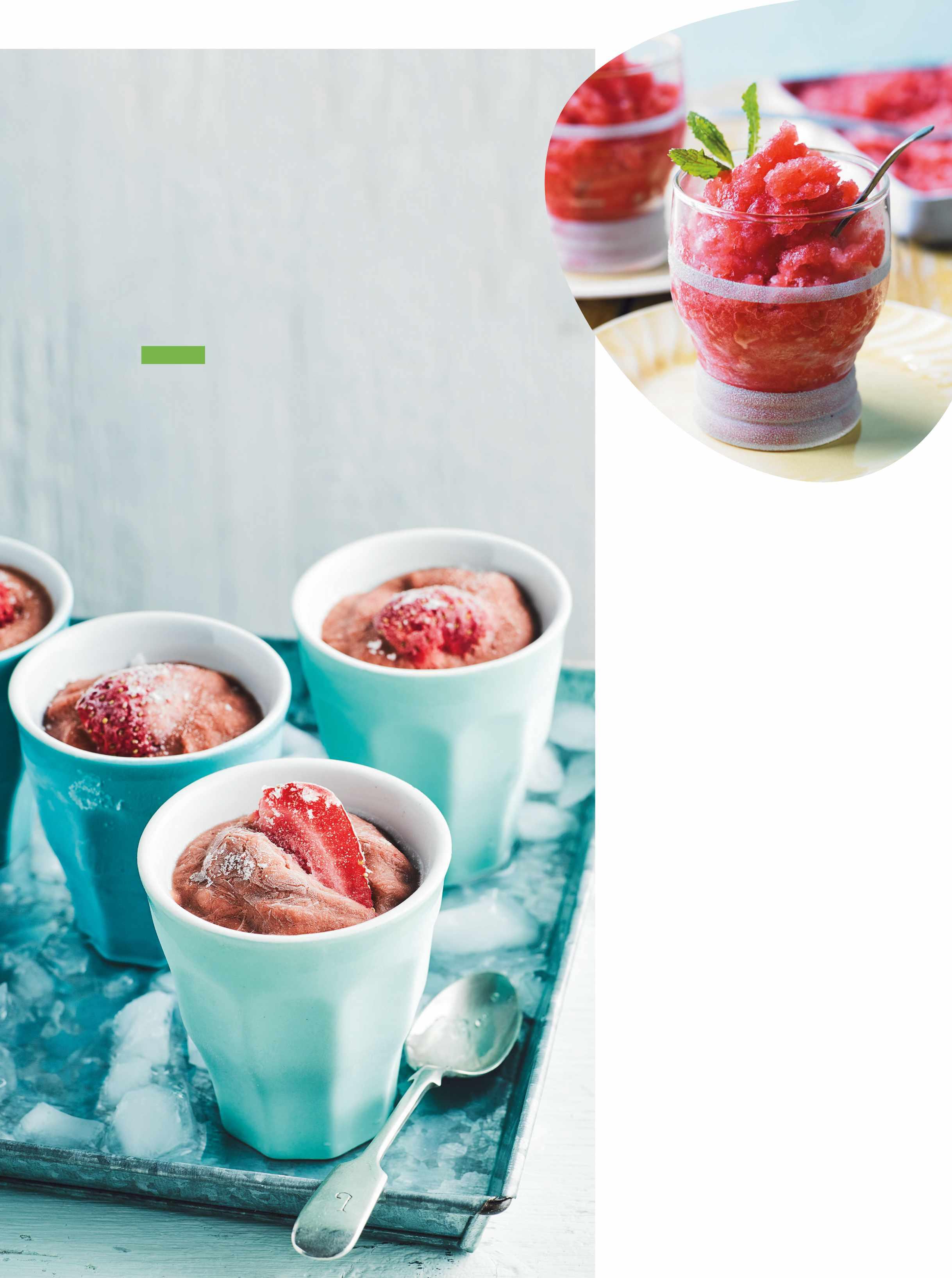
1 Put the strawberries (save four pieces for the top), avocado, vinegar and vanilla in a bowl and blitz using a hand blender (or in a food processor) until as smooth as you can get it. Have a taste and only add the maple syrup if the strawberries are not sweet enough.
2 Pour into containers, add a strawberry to each, cover with cling film and freeze. Allow the pots to soften for 5-10 mins before eating.
Light, bright and bursting with berry flavour – this icy strawberry and mint granita is the perfect palate-cooling dessert for sunny days
PER SERVING 135 kcals | fat 0g | saturates 0g | carbs 33g | sugars 31g | fibre 2g | protein 1g | salt 0g
SERVES 4 PREP 10 mins COOK 10 mins, plus 4 hrs freezing EASY
100g golden caster sugar
450g strawberries, hulled and halved 8 mint leaves, plus extra sprigs to serve
1 Put the sugar and 100ml water in a medium saucepan over a low heat, and stir now and again until the sugar dissolves. Don’t let the syrup boil.
2 Meanwhile, tip the strawberries into a food processor and blend to a purée. Pour into the sugar syrup with the mint leaves and turn up the heat. Simmer for about 5 mins until the mixture thickens slightly. Once thickened, strain through a fine sieve to get rid of any seeds and leaves. Allow to cool for 15 mins.
3 Pour into a container and freeze for 1 hr, then rake the top layer with a fork and put back in the freezer. Repeat every hour for the next 4 hrs until the mix becomes a crystallised slush. Serve in glasses with a sprig of mint on top.
This month, we’re serving up a Chinese-inspired classic that’s packed with spice, crunch and full-on flavour – minus the deep fryer
This tasty chicken recipe from Good Food is the perfect healthy fakeaway – crisp on the outside, tender inside, and tossed with bold, aromatic ingredients. Serve with steamed rice, spring onions and a dash of soy sauce for a feel-good feast that’s fast and fuss-free.
PER SERVING 206 kcals | fat 10g | saturates 2g | carbs 9g | sugars 7g | fibre 3g | protein 20g | salt 1.2g
SERVES 4 PREP 15 mins
COOK 32 mins EASY
400g boneless, skinless chicken
thighs, roughly chopped
1½ tsp cornflour
¾ tsp salt
¾ tsp Szechuan pepper, crushed (or use black pepper)
1 tsp Chinese five-spice powder
1 red chilli, finely chopped

2 red peppers, roughly chopped
6 spring onions (4 roughly chopped,
2 sliced on the diagonal)
1½ tsp olive oil
2 pak choi, leaves separated
½ tbsp honey
1 tbsp Shaohsing rice wine
Cooked rice and soy sauce, to serve
1 Heat the air fryer to 200°C. Combine the chicken with the cornflour, ¾ tsp salt, the Szechuan pepper and five-spice powder. Tip into the air fryer basket and cook for 15 mins until cooked through. Tip onto a
plate and set aside.
2 Tip the chilli, peppers and roughly chopped spring onions into a bowl and toss with the olive oil, then place in the air fryer and cook for 10 mins. Add the pak choi leaves and cook for a further 5 mins. Scoop everything from the air fryer into a bowl along with the chicken, honey and rice wine. Stir together, then return it all to the air fryer and cook for 2 mins. Scatter over the remaining spring onions and serve with the cooked rice and soy sauce.

Track calories at 200+ restaurants
Eating out? No problem! Choose from over 200 popular restaurants and cafés to quickly log meals on the go. Enjoy dining out and stay on track.
Start your 7-day free trial today

Dr Ian Campbell shares his expert opinion
We often hear sugar described as ‘addictive’, but is this genuinely the case from a medical perspective? What happens in our brains when we eat sugar, why do we experience those intense cravings, and how can we manage them sensibly without demonising sugar altogether?
To cut through the sensationalism, we asked Dr Ian Campbell to clarify some common myths, explain how sugar affects our brain, and share practical advice on dealing with sugar cravings in a balanced way.
“Short answer: no,” explains Dr Campbell. “While many people feel they have an addictive relationship with sugar, there’s no clear scientific evidence or consensus that sugar causes a true medical addiction.”
However, there’s no doubt sugar can strongly influence our behaviour. “We’re hardwired from birth to seek out sugar,” Dr Campbell says. “Breast milk contains natural sugars, making babies feel satisfied. As children and adults, we continue to enjoy sweet flavours, sugary drinks, and sugary foods because sugar stimulates dopamine
production in our brains. Dopamine is a chemical that makes us feel calm and content.”
While this dopamine release can make sugar feel irresistible, Dr Campbell is careful to distinguish this from genuine drug addiction. “Sugar’s effect on our brain’s reward system can encourage impulsive behaviours aimed at seeking pleasure,” he notes. “But it’s important to understand that this is very different from the destructive hormonal and personality-altering effects commonly seen with genuinely addictive drugs.”
Understanding sugar cravings
“As with many things, sugar can be beneficial in small amounts but harmful in excess,” says Dr Campbell.
Dr Ian Campbell MBE
“As with many things, the key is moderation”
Cravings often come from our body’s natural cues. “Sometimes craving sugar can be perfectly normal and even helpful,” Dr Campbell explains. “After vigorous exercise or a prolonged period without eating, blood sugar levels can drop significantly (a state called hypoglycaemia), which can affect thinking clearly, cause anxiety, and lead to feeling faint. In these instances, sugar can quickly replenish energy and stabilise blood sugar levels.”
The key is moderation.
So, how can we enjoy sugar without going overboard? “Sugar itself isn’t harmful; it naturally occurs in many foods and is part of a healthy, balanced diet in moderate amounts,” explains Dr Campbell. “A good guideline is around 30 grams – or around seven teaspoons – per day of added sugars.”
Reducing our sugar intake can feel tricky, especially since added sugars are so common in everyday products like sugary drinks, processed foods, biscuits, chocolates, and cakes. But there are helpful strategies for managing cravings effectively. “If a craving feels overwhelming, distraction techniques can work well,” Dr Campbell advises.
For over 30 years, Dr Campbell has passionately promoted a holistic approach to weight management. He was the show doctor on three seasons of ITV’s Biggest Loser and works closely with Nutracheck to help our members live healthier, happier lives.



“Try brisk exercise, immerse yourself in a good book, or engage in a task that demands your full attention. And if you do end up enjoying a sugary snack, don’t feel guilty or beat yourself up. Negative feelings only feed cravings further – it’s a cycle that’s best avoided.”
Do we need to avoid sugar completely?
“No, sugar doesn’t need to be completely off-limits,” says Dr Campbell. “It’s natural and enjoyable as part of a balanced diet – the key is moderation. While many of








us occasionally feel compelled to consume sugar, even when we know it’s not the healthiest choice, we can find a balanced approach.”
If you’re genuinely struggling with managing sugar cravings or finding it difficult to maintain a balanced diet, it’s best to seek professional guidance from your GP or dietitian. Talking to a qualified healthcare professional can help identify underlying issues, offer personalised advice, and support you in making lasting, healthy changes.


“Sugar is a natural part of our diet, and there’s no solid scientific evidence it causes true addiction. But many people experience powerful cravings. My advice? Be the boss of your health and wellbeing – you can enjoy sugar without it controlling you. Keep an eye on how much added sugar you’re consuming and reduce it if needed, aim for a balanced diet, and stay physically active. If you do eat more sugar from time-to-time, remember that moderation and self-compassion are key.”




Quick barcode scanning for effortless tracking
With Nutracheck’s barcode scanner, tracking your daily diet couldn’t be simpler. Scan food packaging and add it to your daily diary with ease.
Start your 7-day free trial today